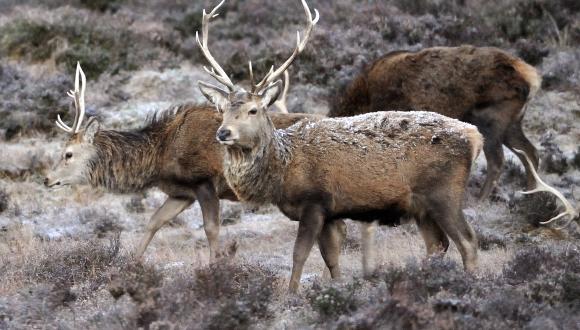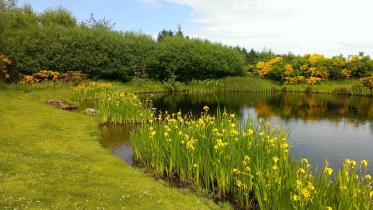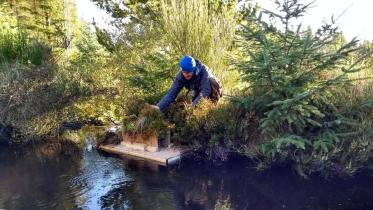Sustainable Deer Management in North Lanarkshire - Information Gathering Project
Published: 2022
Created: May 2019
Prepared by Lindsay Mackinlay MSc MCIEEM, Principal Ecologist, Parnassus Ecology on behalf of NatureScot and North Lanarkshire Council
Executive Summary
Parnassus Ecology was commissioned by NatureScot to carry out a data gathering exercise on roe deer and associated issues within North Lanarkshire owned and leased land, in order to help inform a review of future deer management in North Lanarkshire Council (NLC). This work also includes the identification of any gaps in knowledge about deer in the North Lanarkshire area and recommendations for future action.
The work did not involve any field surveys but instead was primarily desk-based, with some site visits and much consultation with relevant NLC staff, partners and relevant parties, either face-to-face or via the phone. The main findings of this project are as follows:
- Current NLC strategic plans, policies and guidance covering development, biodiversity and open space, do not specifically address deer issues at this time. There is no specific Council deer management strategy.
- The main deer species in North Lanarkshire is the roe deer (Capreolus capreolus). It is widely distributed across the whole of North Lanarkshire and is probably present on almost all NLC land.
- Deer numbers and densities at individual sites and across North Lanarkshire are impossible to reliably calculate with the current level of data. Deer numbers from known counts are highly variable, commonly from 0 to 20 deer/km2. Crude calculations suggest that the minimum average deer density within North Lanarkshire is possibly 6 deer/km2, making a total population of at least 3240 deer (almost 1 deer for every 10 residents). It is estimated that at least 225 deer presently live on NLC’s Country Parks and Local Nature Reserves alone: 7% of the NL total. These figures should be viewed with caution at this time.
- The majority of older NLC woodland management plans do not identify roe deer as a major issue, however new woodland creation schemes have spent over £330,000 on new deer fencing.
- Over 95% of woodlands owned by NLC are not subject to Woodland Herbivore Impact Assessments and have no or little deer count census data. A similar situation applies to woodlands managed by many partner organisations, with the exception of Forestry Commission Scotland.
- Reported Deer Vehicle Collisions in North Lanarkshire currently stand at over 110 a year, however, in line with other studies, the real number could be between 220 and 550 a year. The overall trend is one of increasing DVCs.
- There is no data on the cases of tick-transmitted Lyme’s disease contracted by the public from sites within North Lanarkshire. However, general opinion is that ticks are not a major issue at the moment on NLC land.
- There is some data on the number of cases of wildlife crime committed involving deer in North Lanarkshire and on NLC land. However, specialist opinions suggest the actual number of cases to be extremely high.
- There are no licensed venison dealers based in North Lanarkshire and there is currently no data available to indicate how much venison from local deer is being consumed by local people.
- The 14 Areas of Public Interest* which are considered central to deer management planning processes in Local Authority areas are currently not being fully met in North Lanarkshire.
- It is recommended that the following actions be prioritised in order to address the most urgent data deficiencies in the short term (within the next 2 years) and to provide the foundations to address other data issues in the medium term (within next 5-10 years):
*The 14 Areas of Public Interest are the benefits to the people of Scotland which can or could potentially be delivered through sound deer management, as identified by the Deer Code and NatureScot.
Action
- Develop a co-ordinated programme of woodland herbivore impact assessments across key woodland sites (and agree acceptable levels of browsing damage);
- Agree a deer survey and monitoring programme with SNH and other partners which provides frequent, robust scientific data around key sites, in particular those around DVC hotspots, SSSIs and key NLC sites;
- Develop a public system of deer sighting reporting across North Lanarkshire;
- Establish a North Lanarkshire Deer Forum with all interested parties, including representatives from the North Lanarkshire Deer Management Group, Police Scotland and SSPCA, in order to start the development of an action plan to address many of the data issues highlighted in this report;
- Commence the development of a Deer Management Strategy and Plan for NLC land and North Lanarkshire, which sets out how the Council will support the 14 Areas of Public Interest.
1. Introduction
The Roe deer (Capreolus capreolus) is one of two native deer species to Scotland, having been present both before and after the last Ice Age, probably being at their most abundant in the Mesolithic period (between approximately 11,000 and 6000 years ago) when the country had a high level of tree cover (Yalden, 1999). From then until the mid-20th century, much woodland was cleared by man and laws changed to allow all landowners to hunt roe deer, such that by the end of the 18th century, they had become extinct in England and lowland Scotland. It is not clear if this also applied to North Lanarkshire, whose woodland cover had reduced to 4.2% prior to the 20th century (NLLBAP, 2015), however, it seems likely that some roe deer were present in some wooded enclaves.
However, in Scotland, roe deer populations did survive and their recovery began in the mid-19th century, taking advantage of new woodlands being planted on many estates. In the last 50 years or so, the pace of tree planting has vastly accelerated as a result of national and regional forest strategies and the greening of urban areas as heavy industrial sites have been decommissioned. Coupled with less hunting in many places (with fewer farmers on the land), and a lack of natural predators, this has undoubtedly been to the benefit of roe deer, whose populations have greatly increased to number about 300,000 animals in Scotland (Scottish Parliament, 2013).
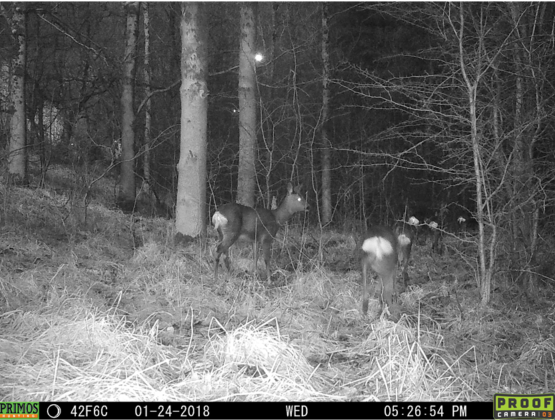
As a result of this big population increase, roe deer have now become an increasingly common and often popular sight in our countryside and towns. However, the successful return of one of our main wild herbivores has not been without its problems, with roe deer now increasingly bringing several challenges to the modern land manager. In particular, these relate to the roe deer’s impact upon forestry schemes, natural woodland regeneration, Deer Vehicle Collisions (DVCs), as well as other issues relating to illegal hunting, damage to gardens and as a host to ticks, with related concerns about Lyme’s disease.
In response to these issues, much legislation and guidance has been reviewed and updated by the Scottish Government and its agencies in order to provide the necessary framework for the sensible management of deer in lowland Scotland, including North Lanarkshire.
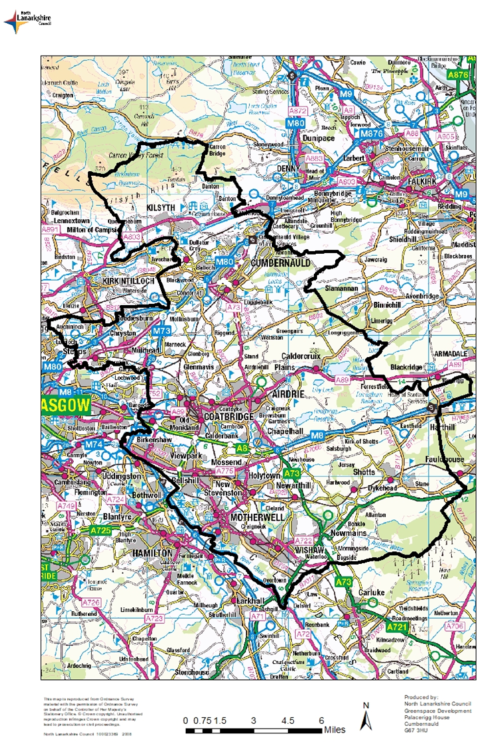
1.1 Project Aims
It is considered that there are four main stages to any deer management planning within any area. Broadly, these stages are as follows:
Stage 1: Context for deer management planning (data collection and analysis: the baseline)
Stage 2: Setting Objectives
Stage 3: Action Plan
Stage 4: Monitoring and Review
This project has been commissioned by Scottish Natural Heritage (SNH) to support Stage 1 of deer management planning within the North Lanarkshire Council (NLC) area (Map 1).
This project has involved the collation of available data on deer and a clear analysis of the key factors that could influence the approach to deer management in the North Lanarkshire Council landholding. As a result, it has been possible to capture and clearly articulate the Public Interest currently being delivered in North Lanarkshire, and, to a certain extent, quantify it. In particular, the aims of this project have been to:
- Collate, analyse and present existing information and data on deer impacts and deer populations including, but not limited to, information on deer distribution, deer vehicle collisions, herbivore impacts assessments in woodlands, deer census data, cull returns, etc.
- Approach relevant private landowners, community groups and other key stakeholders (Forestry Commission, SNH, adjoining councils, local deer groups, Seven Lochs Wetland Park) to examine the range of public and private interests associated with deer in North Lanarkshire. This has included consideration of the impact of land management and development planning challenges on future deer management in North Lanarkshire.
- Identify gaps in knowledge and policy where further survey or monitoring or other work is required to assess whether deer are currently being managed sustainably in the council area.
- Produce a report setting out the findings of the information gathering project in a simple, accessible form, and highlighting the key issues relating to each of SNH’s 14 Areas of Public Interest that North Lanarkshire Council will need to take account of during their decision-making and land management in the future, and provide recommendations for policy development.
This project was primarily focussed on all land in the Environmental Facilities portfolio of North Lanarkshire Council (Maps 2, 3, 8; Appendix 5). This currently comprises:
- 3 Country Parks
- 6 Town Parks
- 3 Formal Gardens
- 9 Local Nature Reserves
- 32 Cemeteries and churchyards
- 19 Urban Woodlands brought into active management through the Forestry Commission Scotland’s ‘Woodlands In and Around Towns’ (WIAT) initiative and other grant schemes.
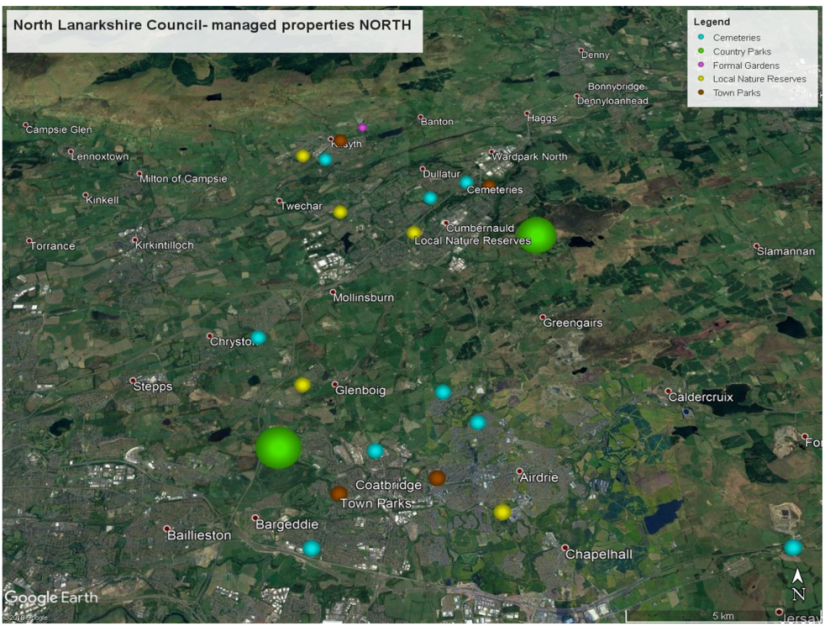
North Lanarkshire Council Map of managed properties North
Legend showing
- Cemeteries
- Country Parks
- Formal Gardens
- Local Nature Reserves
- Town Parks
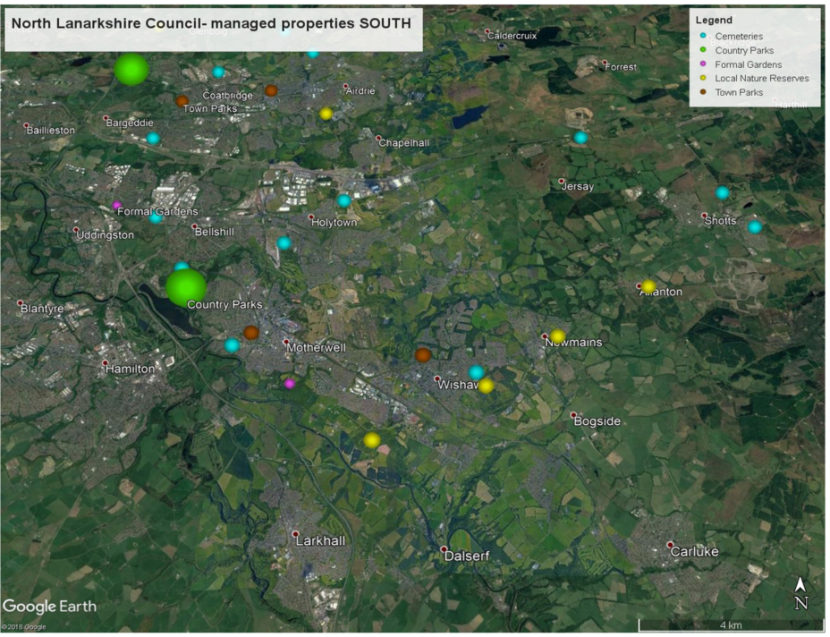
North Lanarkshire Council-managed properties South
Legend showing:
- Cemeteries
- Country Parks
- Formal Gardens
- Local Nature Reserves
- Town Parks
Consideration was also given to relevant neighbouring land managed by partner organisations where it was felt to provide useful information to help inform future deer management planning in North Lanarkshire and within NLC land.
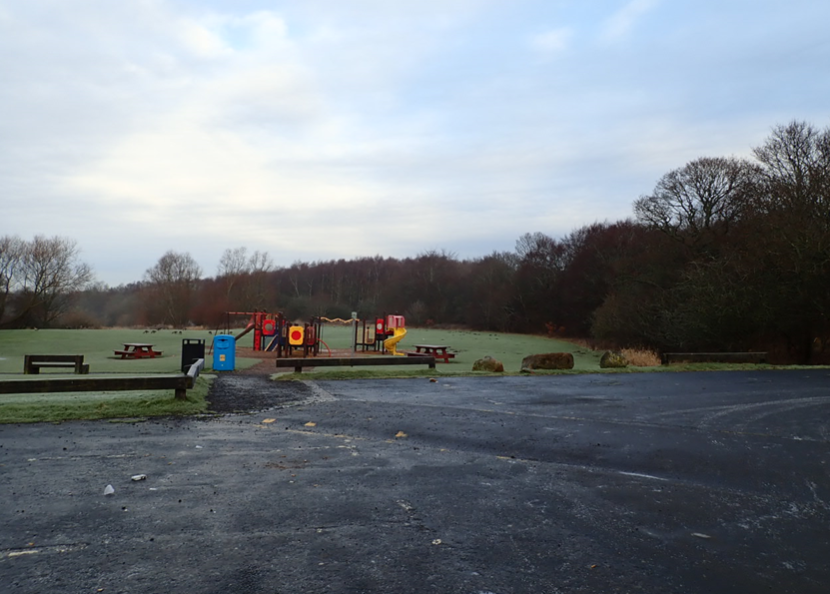
2. Methods
This project primarily involved collecting, analysing and assessing existing data held by the Council and relevant partners, as well as gaining important information via discussions with all key persons involved with deer management in North Lanarkshire. No fieldwork was carried out beyond site visits to gain a better understanding of the nature and factors affecting key sites.
A key part of the project was also trying to obtain historical as well as current deer data, in order to assess any trends across North Lanarkshire and within NLC sites. For example, NLC woodland management plans, dated from around 2006-2007, held useful information on deer impact observations within woodlands at that time, whilst the Deer Vehicle Collision data used went back to 2009.
The full list of consultees approached during this project are included in Appendix 9.
Following this phase, gaps in knowledge were identified whilst current deer management was assessed against the 14 Areas of Public Interest (See Section 3.2 below). Finally, general recommendations for future action were highlighted to help address current data issues.
Due to the nature of the data and the species, many impacts relating to deer were considered beyond the boundaries of NLC land-holdings.
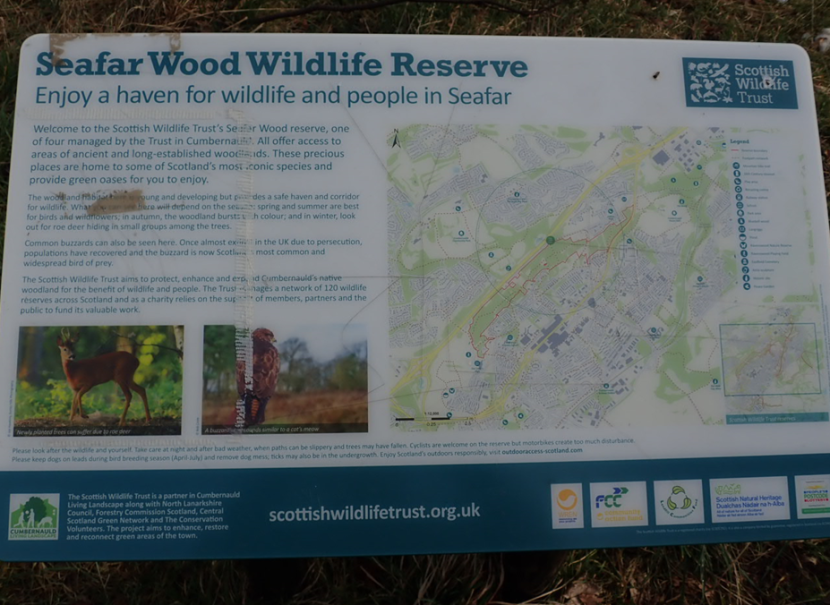
In 1995 the Scottish Wildlife Trust acquired 290ha of mixed woodlands from the Cumbernauld New Town Development Corporation. This land was transformed into four nature reserves, providing an important haven for plants and wildlife, which connects with NLC-owned land at Cumbernauld. (Note roe deer information on browsing on panel)
3. Strategic and Council Policies and Deer Issues within North Lanarkshire
A key part of this work was considering the strategic context to roe deer within North Lanarkshire, including an examination of relevant Council policies.
3.1 Strategic Legislative and Policy Context
It is not the aim of this project to set out and review all the national strategic policies that relate to roe deer in Scotland and North Lanarkshire. Instead, the key policy drivers will be highlighted here in order to assist policy decision-makers with their future work in North Lanarkshire (Table 1 below). Particular attention is given to the recent report from the Lowland Deer Panel in February 2019.
The main legislation covering deer and their management in Scotland is the Deer (Scotland) Act 1996. The delivery of the aims of this legislation is expected to be delivered through Scotland’s Wild Deer: A National Approach (WDNA), which encompasses a 20 year vision for wild deer management. Launched in November 2008, and subsequently reviewed in 2014, it was developed and is being delivered by private and public bodies working together.
The WDNA is relevant to all species of wild deer in Scotland and all types of land ownership and land management, from the uplands to towns and cities. It is relevant to all organisations and individuals who have an interest in deer and their management. Wild deer are managed throughout Scotland by a wide range of land management interests including individuals, businesses, recreational and community bodies and organisations across private, voluntary and public sectors.
In legal terms, wild deer belong to no-one. We all however have a ‘responsibility’ to look after the natural resources of Scotland, which includes deer. In most circumstances, this responsibility is not a legal obligation but a moral and social one. The concept of responsible deer management focuses on three main areas:
- Managing deer as a resource sustainably;
- Minimising negative deer impacts on public interests;
- Safeguarding deer welfare.
In order to assist with these management objectives, the Code of Practice on Deer Management (aka The Deer Code) was approved by the Scottish Parliament in 2012 and describes what everybody who owns or manages land on which wild deer occur must, should and could do to support sustainable deer management.
Public bodies, such as North Lanarkshire Council, are required to take account of the Deer Code when carrying out their functions as landowners or managing agents.
Following recommendations arising from the Rural Affairs, Climate Change and Environment Committee Enquiry in 2013 and the subsequent review of deer management carried out by Scottish Natural Heritage (SNH) in 2016, support to Local Authorities was identified as a key area to take forward. As part of this support, SNH has been funding a number of projects to assist Local Authorities in lowland Scotland commence the deer management planning process, including the production of effective and environmentally responsible management statements and plans.
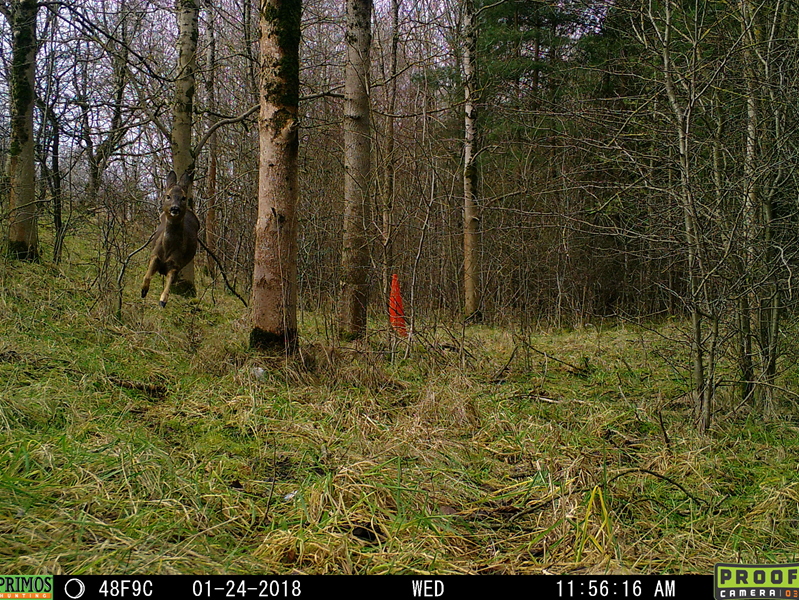
Table 1 - Summary of key national policies, plans, strategies and legislation relating to deer
- The Scottish Government’s National Performance Framework (NPF): National Indicator (NI) 44: Improve the condition of protected nature sites.
- ‘Deer Management in Scotland: Report to the Scottish Government from Scottish Natural Heritage 2016’ (in response to the recommendations of the Rural Affairs, Climate Change and Environment Committee of the Scottish Parliament)
- ‘Scotland’s Wild Deer: A National Approach’ (or WDNA) (2008, 2014)
- The Deer (Scotland) Act 1996 (this Act consolidated and replaced the Deer (Scotland) Act 1959)), including as amended by the Wildlife and Natural Environment (Scotland) Act 2011 (WANE) and the Land Reform (Scotland) Act 2016.
- ‘The Code of Practice on Deer Management’, aka the Deer Code, as well as the well-respected Best Practice Guides developed by SNH in collaboration with the industry: www.bestpracticeguides.org.uk
- Scotland’s Forest Strategy 2019-2029 (within a 50 year vision): This strategy recognises the positive importance of deer to woodlands as well as their threats: ‘Invasive species and deer both restrict the natural regeneration of forests and woodlands and increase establishment and management costs…’ It also states that ‘The Scottish Government supports the principles of the WDNA and this Strategy will support the implementation of the WDNA. The sustainable management of wild deer populations, the protection of trees from herbivore browsing……are therefore important aspects of resilience and sustainable forest management’. The strategy goes on to state that “Scotland’s planning authorities are also critical in delivering this Strategy through their role in the planning system and the implementation of the supportive framework for trees, forests and woodlands, including the development of local Forestry and Woodland Strategies..’
- 2020 Challenge for Scotland’s Biodiversity: A Strategy for the conservation and enhancement of biodiversity in Scotland (Scottish Government, 2013): This strategy is a supplement to the Scottish Biodiversity Strategy (2004) and sets out ‘desired outcomes for 2020’. In terms of roe deer, it does highlight the need to manage deer populations sustainably and supports The Deer Code. It also recommends using data from the Native Woodland Survey of Scotland (NWSS) to guide woodland management, and highlights the continuing role of Local Biodiversity Action Plans in contributing to national biodiversity priorities e.g. woodland expansion, national ecological networks.
- Beyond the Glen: A strategy for the Scottish Venison Sector to 2030 (Scotland Food & Drink, 2018)
- Lowland Deer Panel Report to Scottish Natural Heritage (February 2019)
-
Lowland deer management: assessing the delivery of public interests. Scottish Natural Heritage Research Report No. 1069. (McMorran et al, 2019)
3.2 Areas of Public Interest
The WDNA and associated Deer Code have highlighted a range of benefits to the people of Scotland which can or could potentially be delivered through sound deer management. These benefits are also referred to as the “Public Interest” and SNH has identified 14 Areas of Public Interest derived from the Deer Code and linked to a number of areas of Scottish Government policy (Table 2 & Appendix 1 for full wording). These have been distilled from work done across the wider Scotland area, and although they were originally focussed on upland red deer, they equally apply to the lowlands and to other deer species, including roe deer in North Lanarkshire. These 14 Areas of Public Interest are considered central to deer management planning processes in Local Authority areas.
Table 2 - 14 Areas of Public Interest
- Contribute to the delivery of designated features into Favourable Condition through managing deer impacts.
- Contribute to the Scottish Government woodland expansion target of 25% woodland cover.
- Manage deer to retain existing native woodland cover and improve woodland condition in the medium to long term.
- Monitor and manage deer impacts in the wider countryside (not improved agricultural land)
- Improve Scotland’s ability to store carbon
- Reduce or mitigate the risk of establishment of invasive non-native species
- Protect landscapes and historic features from deer and deer management activity
- Optimise economic benefits of Deer Management in Scotland
- Minimise the economic cost of deer
- Contribute to delivering higher standards of competence in deer management
- Identify and promote opportunities contributing to public health and wellbeing benefits
- Ensure effective communication on deer management issues
- Ensure deer welfare is taken fully into account at individual animal and population level
- Develop effective mechanisms to manage deer.
3.3. North Lanarkshire Council and related Policies
At present, North Lanarkshire Council does not have a specific deer or deer management policy or strategy.
This project considered various other policies and plans within North Lanarkshire Council, including the following:
- North Lanarkshire Local Biodiversity Action Plan 2015-2020 (NLLBAP)
- North Lanarkshire Modified Proposed Plan Policy Document 2018 (with Map Books)
- Open Space Strategy August 2004
In consultation with NLC, the Public Access Strategy 2001 was not considered relevant as it is out of date and about to be replaced by a new access strategy framework.
None of these documents have any specific deer or deer management objectives. However, several elements to these plans will either impact upon or be impacted upon by deer:
3.3.1. North Lanarkshire Local Biodiversity Action Plan (NLLBAP) 2015-2020
Key action plans within the NLLBAP have the potential to either affect or be affected by roe deer. This includes the following:
- Woodland Action Plan
- Farmland Action Plan (inc Floodplain and Grazing Marsh Plan & Hedgerow Action Plan)
- Urban Action Plan (inc School Grounds Plan, Golf Course Plan & Open Mosaic on Previously Developed Land Plan)
The Woodland Action Plan does note ‘that controlling over-grazing……by deer is required to ensure that natural regeneration is part of the recovery of wooded landscapes’, however, it does not have any further proposals or objectives with regard to roe deer. The Woodland Action Plan also refers to the past development of a Council Woodland Strategy, however, this document has not been written at this time.
None of the other plans mentioned roe deer or the plan’s role in the maintenance of roe deer populations.
The NLLBAP has produced an extremely useful analysis of population trends of key species, identified within the Council area by the Council and via consultation with all conservation partners, between 1999 and 2014. However, roe deer were not included within this assessment and there is therefore no Council-wide assessment on roe deer population trends at this time.
3.3.2. North Lanarkshire Local Development Plan
The current Local Development Plan, North Lanarkshire Local Development Plan Modified Proposed Plan Policy Document 2018 (with Map Books), sets out the policies and proposals to guide development within North Lanarkshire over the next 5-10 years. It would not be expected to have any policies or proposals specifically relating to roe deer within it, however, the proposals within it have the potential to significantly impact upon roe deer populations in certain localities, both directly, through loss of habitat to development, and indirectly, through increased human disturbance as housing encroaches on roe deer habitat or traffic volume increases in key roe deer hotspots.
One such example is the area of land between Cumbernauld and Palacerigg Country Park, and adjacent to the Scottish Wildlife Trust’s (SWT) Forest Nature Reserve: the South Cumbernauld Community Growth Area. The proposals will see a significant area of countryside set aside for much housing directly adjacent to one of the roe deer hotspots in the Council area, where there are existing high roe deer densities and many Deer Vehicle Collisions (DVCs). The Gartcosh and Glenboig Community Growth Area shares potentially even more significant roe deer issues due to the high roe deer densities beside a congested busy road network. The concept statements associated with these areas set out that developers will need to take wildlife into account during their environmental impact assessments and proposals, however, there is no specific mention of roe deer issues.
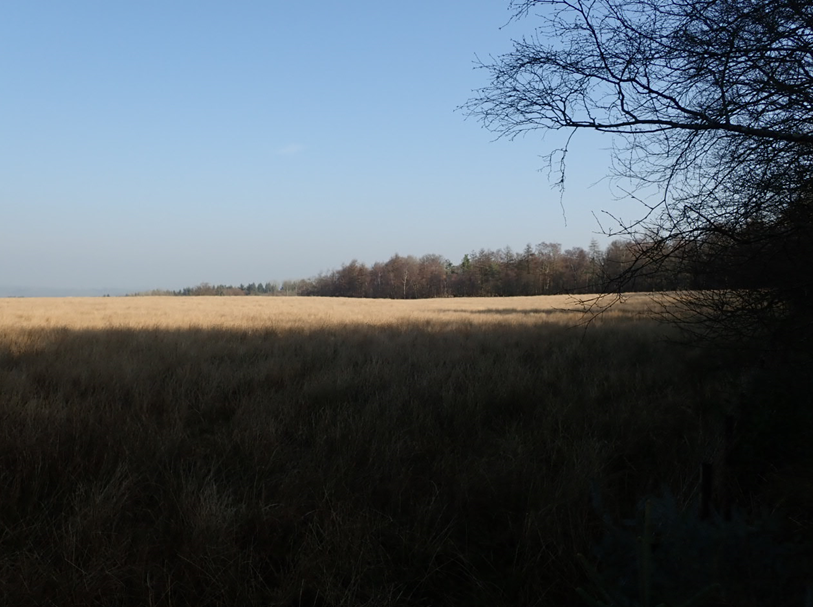
The Local Development Plan does, however, have associated extremely useful guidance notes to assist developers with their planning applications. These are called North Lanarkshire Council Supplementary Planning Guidance notes e.g. SPG02 Trees and Development, SPG 20 Biodiversity, etc, with the majority dated between 2009 and 2011. The guidance within these notes will have impacts upon roe deer as they address wildlife issues, such as the maintenance and enhancement of green networks, tree planting, etc, however, roe deer do not appear to currently get a specific mention within any of the notes.
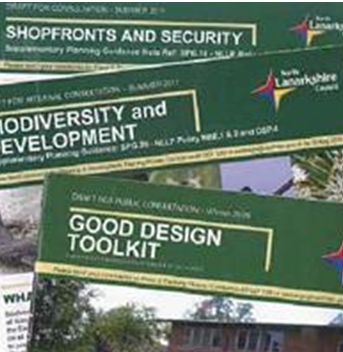
3.3.3. Open Space Strategy
This document, published in August 2004, sets out the context for activities and programmes that will provide high quality and accessible open spaces within North Lanarkshire. It is now over 15 years old, however, it has arguably been superseded by the Glasgow & Clyde Valley (GCV) Green Network and its associated strategies where parts of North Lanarkshire sit within the network area.
A key part of this strategy is the protection and development of a robust green network across the area, including more significant woodland creation e.g. increasing cover by 50%, greening of vacant and derelict land e.g. Bothwell Park (Uddingston), and supporting the development of key initiatives in the area e.g. The Cumbernauld Living Landscape Initiative, The 7 Lochs Wetland Park. There is much data on the distribution and quality of open space associated with this work, including that managed by Greenspace ScotlandOpens, which produced the first published record of urban open spaces in North Lanarkshire.
However, there is no assessment of the impact of these proposals on roe deer and their populations within any of the current green network strategies, nor the impact of roe deer on greening interests and the public e.g. increase in DVCs, potential risk of increased tick populations.
4. Inventory of Land within North Lanarkshire
North Lanarkshire sits between Glasgow and West Lothian, covering several key strategic transport corridors and green networks, most notably along the M8, M73 and the M80. The current population of North Lanarkshire is currently approximately 338,000, split over several large towns in the area, including Cumbernauld, Airdrie & Coatbridge, Motherwell and Wishaw. In terms of greenspace, North Lanarkshire Council has many significant areas, including its internationally important raised bogs, three big country parks and its network of 9 Local Nature Reserves (LNRs), more than any other Local Authority at this time.
Of particular relevance to roe deer, 21% of North Lanarkshire is woodland (cf. national average of 18%) (NLC, 2015), with much of it linear in nature and integrated into urban areas through well-established green networks. This includes a significant number of woodland Site of Importance for Nature Conservation (SINCs), of which many are owned by the Council and are located in close proximity to urban areas, and which also form strong habitat corridors across the Council area (Maps 4 & 5 below).
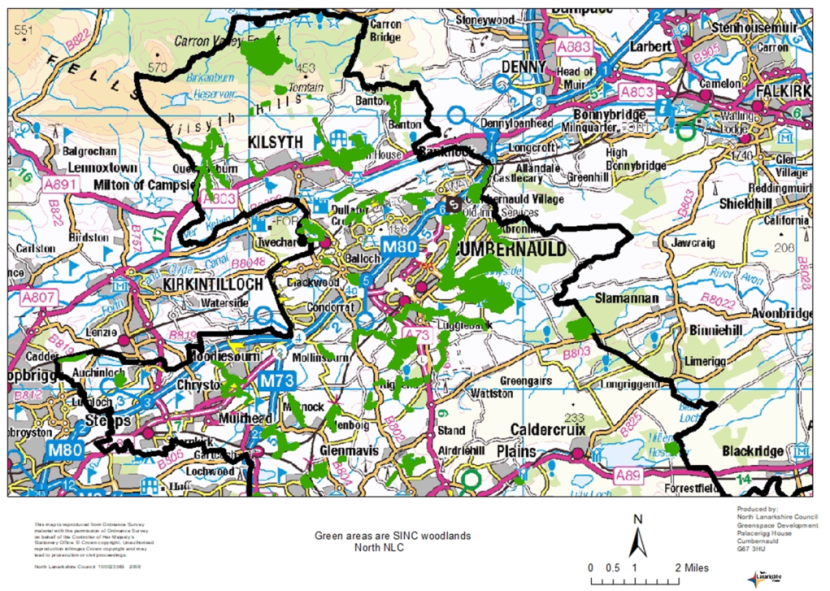
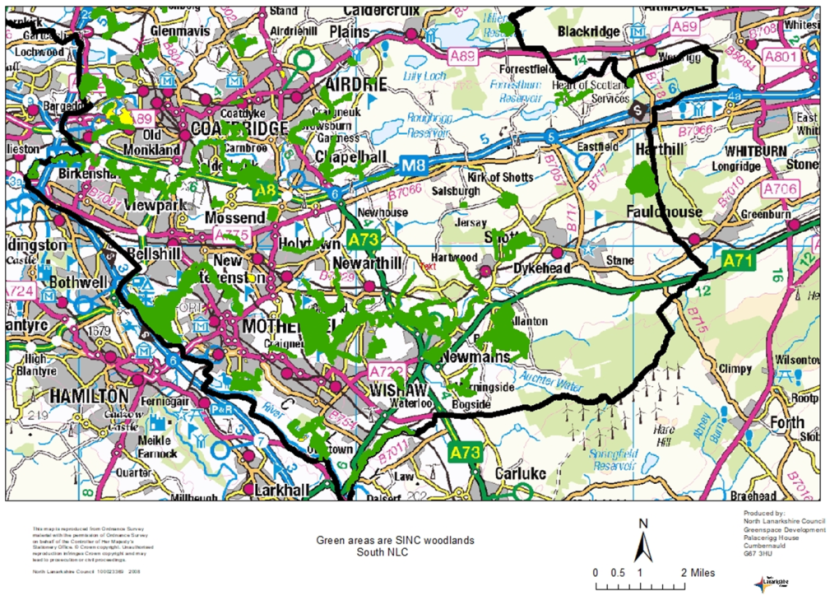
In addition, North Lanarkshire is currently one of the biggest contributors to vacant and derelict land in Scotland, with the sites spread across the council area, particularly in its western half, and which are often ‘green’ in nature (NLC, 2015)(Maps 6 & 7). This includes the largest single area at the former Ravenscraig Steel Works, near Motherwell.
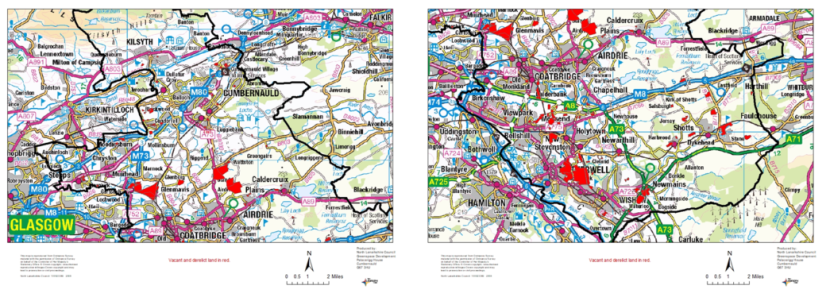
This combination of land uses (woodland and vacant land) has contributed much to increases in roe deer distribution and population size, and associated impacts.
In terms of habitat information, the most recent landscape-scale habitat information collected within North Lanarkshire was through Phase 1 Habitat Surveys. This area-wide survey was carried out approximately 30 years ago and is not available in a digitised form or over the entire Council area. It is therefore considered to be out of date, especially as this time period covers much change in North Lanarkshire, including extensive woodland creation work stimulated by the Central Scotland Countryside Trust and its partners, and the loss of much farmland and other greenspace to housing and other development e.g. Eurocentral, M8 works.
Some individual LNRs have been subject to more recent Phase 1 habitat surveys in 2010.
There is, however, much information on woodland cover and condition within North Lanarkshire, most notably through the Native Woodland Survey of Scotland (Patterson et al, 2014), which mapped all native woodland sites within the Council area and also assessed herbivore impact.
An inventory of the land under NLC ownership is presented in Tables 3 and 4.
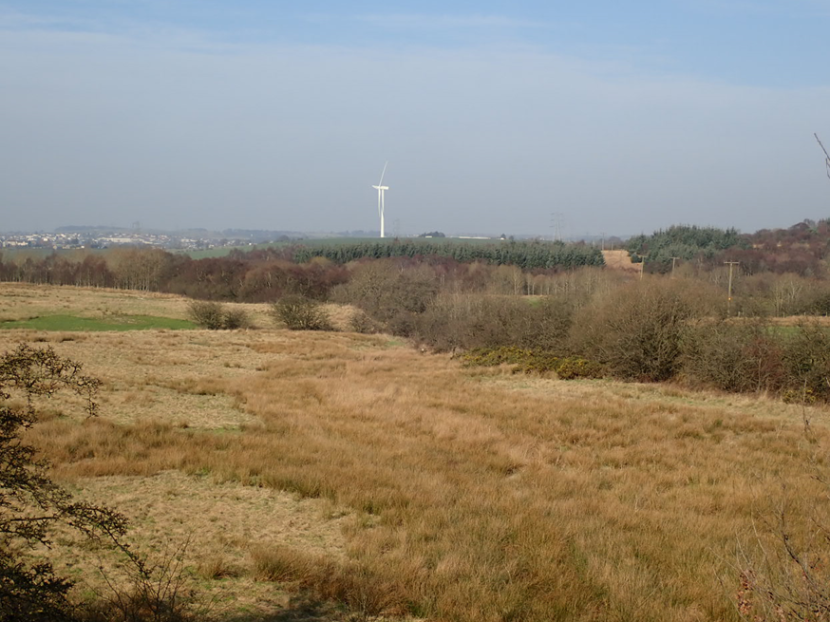
Typical scene near Chapelhall, north of the M8: Mix of woodland types and rough agricultural land: Plenty of good habitat for roe deer close to major road networks and towns.
|
- |
Area (ha) |
% of Total Council Area |
Data Source |
|---|---|---|---|
|
North Lanarkshire Council Area |
46990 |
- |
|
|
Urban Area |
9000 |
19 |
Open Space Strategy (2004); North Lanarkshire Council |
|
Non-Urban Area |
38000 |
81 |
Open Space Strategy (2004); North Lanarkshire Council |
|
Golf Courses (15 courses) |
960 |
2 |
NLLBAP 2015-2020 |
|
Vacant & Derelict Land |
1310 |
3 |
2013 Vacant and Derelict Land Survey via NLLBAP 2015-2020 (& Open Space Strategy (2004); North Lanarkshire Council. |
|
Area maintained by NLC |
3,722 |
8 |
Open Space Strategy (2004); North Lanarkshire Council |
|
- |
- |
% of Area maintained by NLC |
- |
|
Country Parks |
1027 |
28 |
SNH Site LINK |
|
Local Nature Reserves |
486 |
13 |
NLC website and LNR management plans |
|
Major Town Parks |
46 |
1 |
NLC website |
|
Operational Cemeteries |
92 |
2 |
NLC website |
|
Total |
1651ha |
44% |
- |
Note figures have been rounded up or down where decimal points. Note that 6 LNRs (Braedale Hill, Brownsburn Community Park, Dumbreck Marsh, Gartcosh, Greenhead Moss Community Nature Park, Kingshill) have been formed from former industrial sites.
|
- |
Area (ha) |
% of Total Council Area |
Data Source |
|---|---|---|---|
|
North Lanarkshire Council Area |
46990 |
- |
|
|
Total Woodland Cover |
10000 |
21 |
NLLBAP 2015-2020 |
|
Native Woodland |
2916 |
6 |
NLLBAP 2015-2020 |
|
Ancient Woodland |
461 |
1 |
NLLBAP 2015-2020 & NWSS |
|
Other Woodland (e.g. conifer-dominated commercial plantation) |
6623 |
14 |
|
|
Average Woodland Size |
7 |
|
NLLBAP 2015-2020 |
|
- |
SINC Sites |
% of Area maintained by NLC |
- |
|
Sites of Importance for Conservation (SINCs) owned by NLC with > 50% woodland cover |
581 |
16 |
Greenspace Development Service, North Lanarkshire Council
|
|
Sites of Importance for Conservation (SINCs) owned by NLC with < 50% woodland cover |
112 |
3 |
Greenspace Development Service, North Lanarkshire Council
|
|
Total |
693ha |
- |
- |
Note figures have been rounded up or down where decimal points. Note that some SINCs will encompass SSSIs, Country Parks and Local Nature Reserves.
5. Deer Species, Distribution, Numbers, Densities within North Lanarkshire
5.1 Species
The prime native wild deer species currently in North Lanarkshire is the roe deer (Capreolus capreolus), although the red deer (Cervus elaphus) is now starting to move into the Carron Valley area (Watson, 2018) in small numbers to the extreme north of the Council area from the adjacent Stirling Carse area, where there are currently significant populations. Captive or farmed deer are not currently addressed by this project and it is not clear to what extent there are deer farms in North Lanarkshire. There are currently no captive deer on NLC land (Palacerigg Country Park used to have some captive deer in the recent past).
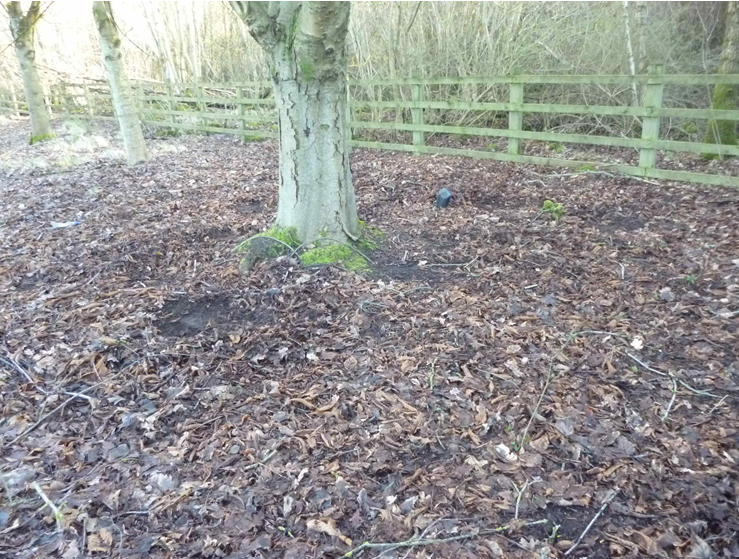
5.2 Deer Distribution and Range
In terms of distribution and range, roe deer are now known to be present across the whole of North Lanarkshire, although the exact dates of their return to many areas is not known, whilst they have probably always been present in other areas within ‘wooded enclaves’. For example, records from Strathclyde Country Park ranger reports show that the first roe deer in many years to be formally noted in that area was in 1986. This contrasts with an estimated current population in that general area of approximately 75 deer (Mackinlay, 2018). It is likely, from discussions with farmers and other land managers during this project, that many other areas in North Lanarkshire share a similar pattern of roe deer population growth in recent times: a conservation success story but one not without its associated issues.
There is little systematic roe deer distribution data available. North Lanarkshire does not currently have an independent Biological Records Centre and the NLC Greenspace Development Service only have the occasional record on their systems. The NBN Living Atlas Scotland website, which is the national database for all wildlife records, has scattered records of roe deer for North Lanarkshire. At present, the most detailed records for roe deer come from thermal image counts, Deer Vehicle Collision data and other survey work carried out by SNH and Forestry Commission Scotland (FCS) or others involved in roe deer management. All these sources confirm the widespread presence of roe deer in North Lanarkshire.
In terms of roe deer presence on land owned and managed by North Lanarkshire Council, further data was obtained from examining relevant management plans, talking to staff e.g. cemetery staff, and NLC visitor websites (where roe deer are often part of the marketing for visiting reserves). The presence and status of roe deer on individual sites is listed in Appendices 4 and 5.
However, in summary, roe deer are currently confirmed to be present on 47% of NLC ‘formally managed’ land e.g. Country Parks, cemeteries, LNRs, etc., but cannot be confirmed as present/absent at this time on 53% of such land (most of this figure relates to cemeteries and town parks). This is primarily because this information is currently unavailable. Given the location of these latter group of sites e.g. beside wooded corridors, it is considered highly likely that roe deer are present on virtually all NLC ‘formally maintained’ greenspace. In terms of NLC woodland sites currently under woodland management plans, 100% have confirmed roe deer presence.
5.3 Deer Numbers and Densities
At present, there is very little scientifically robust data available to provide figures for the roe deer population within North Lanarkshire and within NLC land. Occasional thermal and other counts have taken place across several sites and areas, but these capture a snapshot of numbers at any given time (often in winter when there is less vegetation growth present to obstruct views), being one-off counts often separated by many years. The counts are often carried out from vehicles, such that there are holes in coverage where the terrain cannot be surveyed from the road. In addition, these counts tend to focus on perceived or actual problem areas e.g. around DVC hotspots, where it is already considered there are likely to be high deer numbers present, such that count data is lacking for large tracts of more open countryside away from major trunk roads and forest blocks.
Nevertheless, progress in the development of new thermal image equipment does now allow a more accurate deer count on sites, albeit the counts are minimum numbers of deer on a site at a given time because of the issues already mentioned.
Deer count survey data for the North Lanarkshire area, and some adjacent or very similar areas, was obtained from SNH and FCS. Some of this data covered land owned and managed by North Lanarkshire Council. In some cases, it has been necessary to pull figures for particular sites from area-wide surveys in order to aid an understanding of roe deer populations in specific North Lanarkshire locations. All this data is presented within Appendix 3.
From Appendix 3, it is possible to see that deer density varies massively from site to site, with figures from 3 to 20 deer/km2 being recorded during surveys (with one extreme example of 67 deer/km2). Even within sites, there can be much variation, for example, Bothwell Park had only 4 deer on it during one night-time survey but had 15 on it at a later point, an almost four-fold increase between observations (Watson, 2018). This is not surprising as roe deer can move around in response to feeding opportunities, especially in winter when bigger groups often form in small areas. Furthermore, some sites and areas seem to act as cul-de-sacs for roe deer as they move into favoured habitat but are then confined by physical barriers, such as deer fencing, high walls or large rivers.
This high variability in numbers on a site during counts presents many challenges to the deer or conservation manager. In order to try and address these issues in relation to overall deer numbers in North Lanarkshire and around NLC sites, a landscape-scale approach was used in this project to try and iron out individual site variability and obtain a better but still crude estimate of deer density and deer numbers in North Lanarkshire (Figure 1). This figure is produced in order to provide a starting point for future assessments within North Lanarkshire and on NLC land.
Notwithstanding, it must be stressed that it is not possible with the current survey data available to provide reliable figures for roe deer numbers and densities in North Lanarkshire and on NLC land.
Figure 1 - North Lanarkshire Roe Deer Population Estimate - Worked Example
Four large areas were identified from SNH Count surveys which were felt to:
- represent typical peri-urban areas, and
- appeared to be reasonably covered during the thermal image survey counts via a good road network.
These sites, which varied in size from 6 to 30 square kilometres, are presented in Appendix 3. The average deer density between these 4 sites was 6 deer/km2. However, it must be noted that the survey data on which this figure is based upon are minimum counts and that deer will not be evenly spread across these areas i.e. higher deer numbers in more favoured habitat. The following assumptions are made:
- 6 roe deer/km2 over a varied farmland and urban edge landscape
- 15 roe deer/km2 within a pre-dominantly wooded area (figure based on average of woodland counts in Appendix 3)
Using the data from Land and Woodland Inventories (Tables 3 & 4) and the assumptions above, the following is calculated*:
- 100 square km (10,000ha) of woodland within North Lanarkshire: 100 x 15 = 1500 deer
- 290 square km (28000ha) of non-urban land that is not woodland: 290 x 6 = 1740 deer
Total = 3240 deer
*This calculation does not include 90 square km (9000ha) of urban land recorded within North Lanarkshire, whose definition is not clear and which may well include some significant urban roe deer populations. In addition, Prior (1995) suggests a deer density in British forests of up to 1 deer per 3.2ha (average). At Millburn SSSI (S. Lanarkshire), for example, 3 deer were spotted within a 14ha woodland in early 2019, broadly supporting this figure, such that the figure for woodland deer in North Lanarkshire could be higher in North Lanarkshire. Finally, it is not possible to be sure how many deer are not counted during each thermal image count. However, Mackinlay (2018) noted that the thermal image count over part of Hamilton Low Parks obtained a figure of 22 deer, compared to a figure of 27 during a dawn count 2 months later, a 20% difference, and both considered to be minimum counts.
In terms of land owned and managed by North Lanarkshire Council, the following example is calculated:
15 square kilometres (1513ha) of well-wooded Country Parks and LNRs: 15 x 15 = 225 deer
Given that cumulative minimum counts of 87 deer within the Country Parks alone were obtained (Appendix 3), this figure may not be too far off the mark for these areas only.
5.4 Deer Cull Returns
At this present time, deer culling in North Lanarkshire is broadly carried out by three main groups:
- Forestry Commission Scotland/Forest Enterprise wildlife rangers
- Fit and Competent registered stalkers e.g. contractors, syndicates, including members of North Lanarkshire Deer Management Group
- Poaching/Non-registered stalking
A further group regularly kill deer with dogs, often lurchers, but this cannot be classified as ‘culling’ as venison or deer control is not the main reason for the activity (J. Leonard, SSPCA, 2019, Pers comm).
Cull returns are supposed to be returned to SNH on an annual basis, but in reality, this does not happen everywhere, especially on smaller private landholdings. In addition, the SNH database is not straightforward to interrogate unless you know the name of the landholding i.e. it is not easy to pull out data for ‘North Lanarkshire’. No culling currently takes place on NLC land, with the only previous culling activity taking place on 4 woodland creation sites by CSGNT on behalf of NLC.
Other data on culling is collated by FCS (for their woodland blocks where culling takes place) and the North Lanarkshire Deer Management (NLDMG) Group. The NLDMG members (around 10-15 core members or 3 to 4 FTEs)) annually cull approximately 250 deer (average 5 per week), however, the NLDMG does a lot of shooting outwith North Lanarkshire, such that a detailed breakdown of North Lanarkshire sites was not possible at this time.
Several consultees believe that the number of roe deer lost to illegal activities within North Lanarkshire probably falls into the hundreds of animals.
At present, it is not possible to provide accurate figures for the numbers of deer culled in North Lanarkshire. This information is crucial if roe deer populations are to be managed in a controlled and sustainable manner.
6. Woodland Condition, Deer Impact Assessment and Deer Management Planning
Woodland plays an important role to roe deer in terms of shelter, movement and food. Roe deer can cause significant but often more subtle damage to woodlands than their larger cousin, the red deer. Such impacts tend to be most obvious in woodland creation areas, with lead shoots browsed on planted saplings. However, other impacts tend to be more long-term in showing themselves, being more focussed on impacts upon woodland regeneration, shrub growth and ground flora than more obvious, instant physical damage, such as severe bark stripping and heavy ground disturbance. As a result, roe deer impacts can easily fall under the radar of the land manager for some time unless monitoring is in place.
This study collated information on woodland condition, extent of roe deer damage, the extent to which woodland herbivore impact assessments were being carried out and the degree to which woodland management plans were addressing roe deer impacts. Many of the woodland management plans for NLC-owned woodland were examined whilst information on the work of partners was obtained through consultations. The detailed results are presented in Appendices 5 and 6. However, the results are summarised below:
- There has been no formal evaluation of woodland condition in respect of herbivore damage within any NLC (or NGO) woodlands* since the NWSS work (2011-2013) and that described in the initial plans (2007, 2012, 2015, 2016).
- No Woodland Herbivore Impact Assessments* or deer browsing monitoring have been carried out in any NLC (or NGO) woodland since the NWSS work in 2011-13, despite some plans highlighting roe deer presence as an important issue in the original woodland management plans, namely Westfield Woods, Palacerigg Woods, Eastfield & Balloch (all Cumbernauld), Drumpellier Country Park, Strathclyde Country Park, Newarthill Wood.
- 60% of NLC woodlands appeared to have recorded higher extents of browsing damage between 2006/2007 and NWSS work in 2011-2013, but this is based on comparing anecdotal (but professional) information from earlier plans with more systematic assessments under the NWSS.
- 90% of NLC woodland plans* do not have any specific deer management objectives/prescriptions1 within them beyond a standard recommendation for individual deer guards/shelters around trees in some cases. This possibly reflects a view that roe deer were not a significant issue at the time of the plan production, although it doesn’t explain why no deer objectives were in place for those sites where roe deer presence had been identified as a significant constraint.
* = Hall’s Gill: Hall’s Gill was produced in 2018 and should be viewed as an exemplar for how to integrate deer management into future woodland management planning. 1 = Palacerigg had one prescription to consider deer fencing around one area to protect against deer from the adjacent captive herd. Chapelhall & Calderbank plan (2015) does recommend deer fencing to protect young trees.
Therefore, there is currently no systematic measurement of the extent of deer browsing damage and the impacts upon the woodland within the majority of NLC-owned woodland. However, NLC areas are not alone in this lack of information. A similar picture applies at Baron’s Haugh (RSPB) and SWT’s woodlands around Cumbernauld.
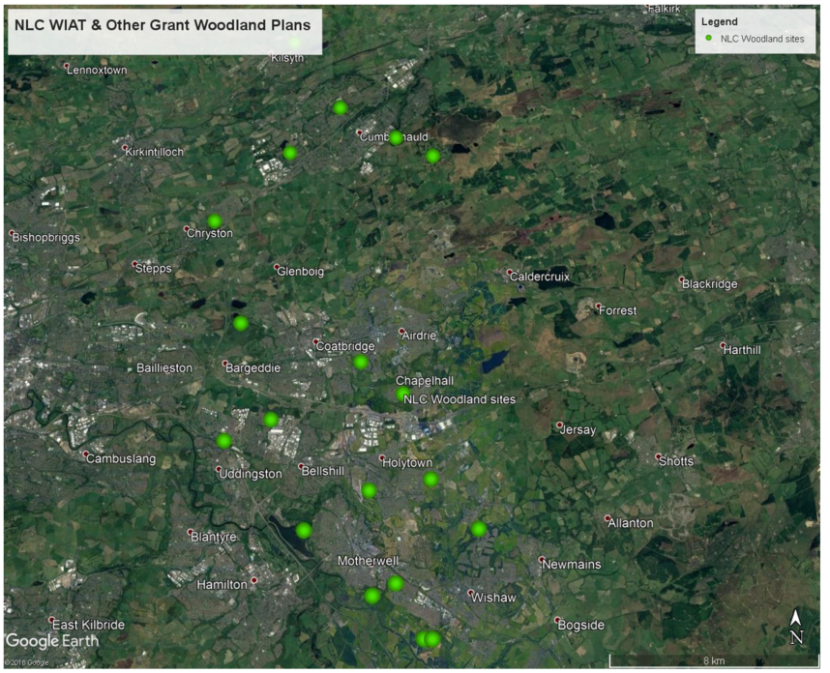
Map showing legend of North Lanarkshire Council woodland sites and other grant woodland plans
7. Statutory Designated Sites
There are 11 SSSIs within North Lanarkshire. Many of these SSSIs are mires, geological, marshes, lochs i.e. habitats that would be unaffected by roe deer browsing and activity. Of the total number of SSSIs present, only 4 were considered vulnerable to deer activity due to the presence of woodland; namely Dullatur Marsh SSSI, Woodend Loch SSSI, Garrion Gill SSSI and North Bellstane Plantation SSSI.
However, only North Bellstane Plantation SSSI and Garrion Gill SSSI have an actual notified SSSI (woodland) feature that could be affected by deer. The latter is the key aspect that is reported upon by SNH and contributes to the Scottish Government’s National Performance Framework (NPF): National Indicator (NI) 44: Improve the condition of protected nature sites.
There are, however, several SSSIs with woodland outwith but directly adjacent to North Lanarkshire, namely Millburn SSSI, Hamilton Low Parks SSSI and Garrion Gill SSSI (South Lanarkshire-side) and Bishop’s Loch SSSI. These sites have also formed part of considerations in this study as roe deer will be moving between them and adjacent NLC land.
The status of roe deer and the condition of the woodland within the 7 relevant SSSIs are described in Appendix 4, and summarised below:
- Only 1 SSSI (Hamilton Low Parks) has had a formal WHIA since 2018. Garrion Gill SSSI had a WHIA in 2016. No other SSSI has had an assessment of roe deer damage since NWSS (2011-13)
- There was no mention of roe deer as a management issue in any of the SSSI Site Management Statements (2009-2010) beyond North Bellstane Plantation (SSSI), near Cumbernauld, where deer browsing was considered to be at an acceptable level.
- The NWSS (2011-13) reported that 4 SSSIs had some areas with a HIGH herbivore impact, a significant proportion of which had been ascribed to roe deer.
- Of the 7 SSSIs, 2 are in Favourable Condition, 4 in Unfavourable Condition, with 1 SSSI not having its woodland monitored as it was not part of a notifiable feature. None of the reasons for the unfavourable condition assessments were due to roe deer. However, these assessments were carried out almost 10 years ago (tbc)
Therefore, there is currently little systematic measurement of the extent of deer browsing damage and the impacts upon the woodland within the majority of SSSI woodland in and around North Lanarkshire at this time. However, there is sufficient evidence to indicate that roe deer are causing significant damage within some SSSIs.
8. Disease Risk - Incidents of Lyme’s Disease in North Lanarkshire
The main disease risk associated with roe deer is Lyme’s Disease, a bacteria transmitted to people via ticks, whose life cycle depends on other mammals, including roe deer. Whilst roe deer do not themselves act as reservoirs for passing on the bacteria to ticks, they can contribute to supporting high tick populations. Ticks are usually associated with more wild land in the Highlands of Scotland, ticks are a known hazard in many woodlands in the central belt, in large part due to the presence of high numbers of roe deer e.g. Pressmennan Wood (E. Lothian)(Mackinlay, pers experience), Former BAE site, Bishopton, nr. Glasgow (M.Findlay, pers comm).
The awareness of Lyme’s disease within the wider public has increased in recent years, however, many people who do not regularly visit the wider countryside are still probably not aware of the disease or its potential symptoms and are therefore less likely to visit their GPs for treatment.
As part of this study, the Annual Report of the Director of Public Health 2016-2017 and appendices were studied for the number of incidents reported to health professionals in North Lanarkshire. Unfortunately, there was no mention of Lyme’s disease within the report as it is not a notifiable disease.
The Department of Public Health (NHS Lanarkshire Headquarters, Kirklands, Fallside Road Bothwell G71 8BB, Telephone: 01698 858241) was therefore contacted to see if they held any other information on incidents of Lyme’s Disease in the Council area. No records were available.
Patients with Lyme’s disease symptoms are undoubtedly turning up at GP surgeries in the NLC area, however, these incidents often remain in a Doctor’s notes (MacLeod, pers. comm) whilst, of course, unless it is specifically noted, it is not possible to know whether a tick was picked up in the North Lanarkshire area, on NLC land or beyond e.g. hillwalkers returning home with an attached tick.
From specific discussions about ticks with local stalkers and conservation staff e.g. NLC ranger staff, it is evident that ticks are not a regular feature in the North Lanarkshire Council area at this time and were not a concern, although a CSGN staff member did feel that tick numbers were on the rise as did a farmer in the 7 Lochs Wetland Park (Craig, Blackfaulds Fm, pers comm).
Recent research suggests that surveillance of ticks and Lyme’s disease within North Lanarkshire would nevertheless be a prudent strategy. Millins C, et al (2017) carried out a recent study into the effects of conservation management, roe deer and the risk of Lyme’s disease transmission. They concluded that ‘available evidence suggests that increasing woodland extent, implementing biodiversity policies that encourage ecotonal habitat and urban greening can increase the risk of Lyme borreliosis by increasing suitable habitat for hosts and the tick vectors’. They went on to recommend ‘that monitoring ticks and pathogens should accompany conservation measures such as woodland regeneration and urban greening projects’.
Another aspect of disease risk may come from the remains of roe deer left by illegal hunting activities in highly urbanised areas. Fit and competent stalkers will not usually leave any roe deer remains on an urban/peri-urban site in order to reduce the risk to the public of possible disease transmission from ‘gralloched’ remains. However, people hunting with dogs will be less tidy. There are no records kept for such incidents at the moment in North Lanarkshire or on NLC land so the extent of this problem and the risk is unknown. A similar issue could apply to deer which have been hit by vehicles but have later died away from the road.
9. Wildlife Crime - Roe Deer Issues in North Lanarkshire
At present, Police Scotland consider that illegal poaching and hunting of roe deer in North Lanarkshire is ‘a constant issue but is massively undetected/unreported to police’. A check of the Police Scotland database shows the following number of incidents (Table 5)
|
- |
2013 |
2014 |
2015 |
2016 |
2017 |
2018 |
|---|---|---|---|---|---|---|
|
Wildlife Crime Incidents involving Deer |
2 |
8 |
5 |
- |
3 |
8 |
All statistics are provisional and should be treated as management information. All data have been extracted from Police Scotland internal systems and are correct as at 21st February 2019. No incidents recorded in 2019 up until 31st January 2019.
Many of these incidents took place in the Motherwell-Shotts-Wishaw general area, and involved dogs (coursing), including one involving dogs within Strathclyde Country Park.
The Scottish Society for the Protection of Animals (SSPCA) consider hunting of deer (and other wildlife) by dogs to be a ‘massive problem’ in Lanarkshire, involving lots of people on a regular basis (often nightly), especially in the Motherwell/Hamilton and Wishaw/Carluke areas, and that reported incidents are ‘the tip of the iceberg’. The SSPCA considered that much of this activity had little to do with venison and more to do with ‘pleasure’.
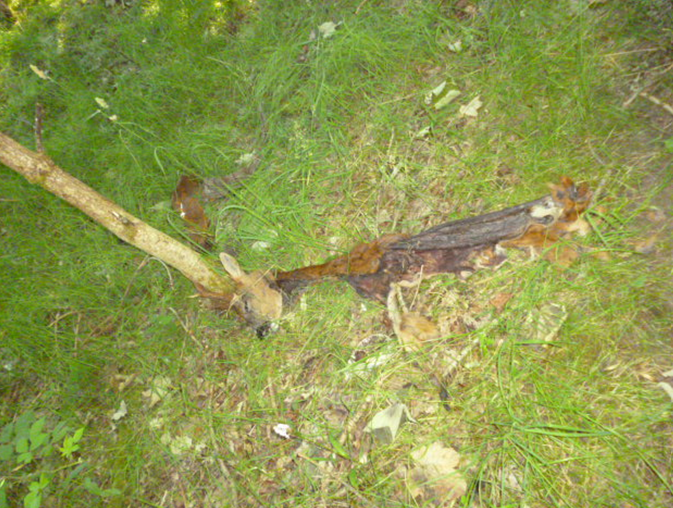
SSPCA hold some data but consider that it is impossible to estimate the total number of deer caught as a result of this illegal activity as deer remains often get taken away completely if hunters are killing for venison, whilst remains from other hunting often get cleared up by wild animals very quickly. In terms of NLC land, the SSPCA considered it highly likely that some illegal activities were taking place outwith hours but because of the timing (dusk to dawn), it was difficult to detect.
Discussions with local ranger staff at Drumpellier and Palacerigg Country Parks revealed that they had found no recent evidence of illegal hunting of deer on NLC land. However, the ranger at Strathclyde Country Park believed the occasional incident was going on there and has been for a while, whilst only one LNR Plan (Greenhead Moss) referred to the need to monitor roe deer runs for snares on a monthly basis (just outside and adjacent to the site).
However, the North Lanarkshire Deer Management Group were aware that illegal hunting of deer is on-going in the area and they felt a significant number of deer were being killed or injured each year as a result of these activities. In addition, the local press do report on incidents when remains or snares are found by the public.
The SSPCA hold some data on these activities but they were not able to supply it during the timescale of this project.
There is clearly a need for more data on this aspect of deer management in North Lanarkshire.
10. Deer Vehicle Collisions (DVCs)
Alongside impacts upon woodland regeneration and forestry, DVCs are probably the most commonly associated issue with deer in Scotland at this time. DVCs are increasingly becoming a significant issue in the central belt of Scotland as roe deer populations continue to expand and increase into peri-urban and urban areas. However, Langbein & Putnam (2007) point out that DVCs are not correlated with high deer densities alone, but with high densities of roads and high traffic volumes of the type found across many areas of North Lanarkshire, and especially the main transport corridors cutting across the Council area, such as the M73, M80, M8 and other key A-roads.
The combination of an integrated green network (with adjacent urban areas), high traffic volumes, major roads and a large roe deer population in many places (sometimes diverted into high risk areas by man-made and landscape-barriers) has resulted in North Lanarkshire having 8% of all recorded DVCs in Scotland; the 4th highest number of DVCs for any Local Authority in Scotland, and second only to Fife in the Scottish Lowlands (Langbein, 2017). Langbein (2017) goes on to point out that DVC incidents handled by the SSPCA have increased in both North and South Lanarkshire 2.5-fold between 2012 and 2015 (tbc).
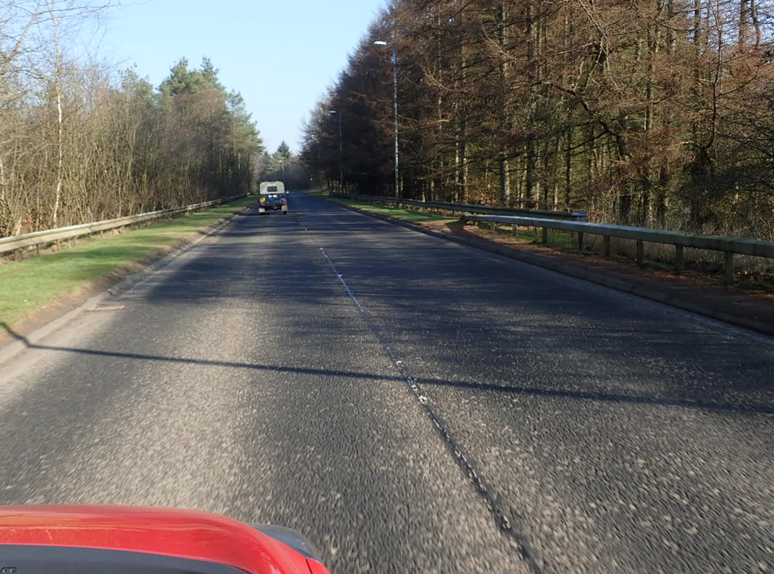
Forest Road, Cumbernauld (adjacent to Palacerigg Country Park). The worst road in North Lanarkshire for DVCs beyond motorways. Note thick woodland on either side making it difficult for drivers to spot roe deer suddenly running across the road.
As part of this project, DVC data from 2009-2017 was collected from Jochen Langbein, who manages the national DVC database on behalf of SNH. The hotspots from the SNH data are illustrated in Maps 9 & 10 below, which clearly show the relationship between busy transport corridors and DVCs. However, this data is not complete but based on those records reported by Transport Scotland, the SSPCA, and Police Scotland. Records from the relevant department of North Lanarkshire Council appear to have been partially included within this SNH dataset but not in their entirety. The main issue is that the records maintained by the NLC ‘carcass pick-up’ teams often do not have a grid reference but are listed by the name of the location e.g. Stirling Road. Therefore, they cannot be included in the national SNH database.
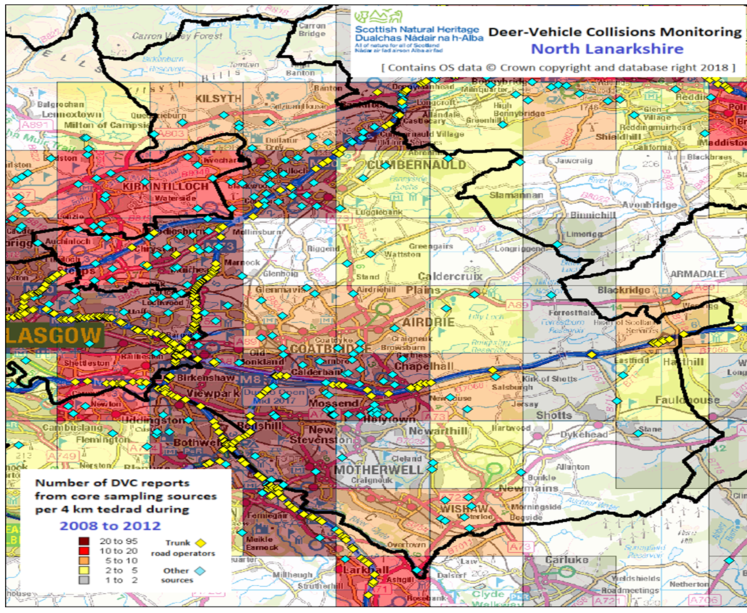
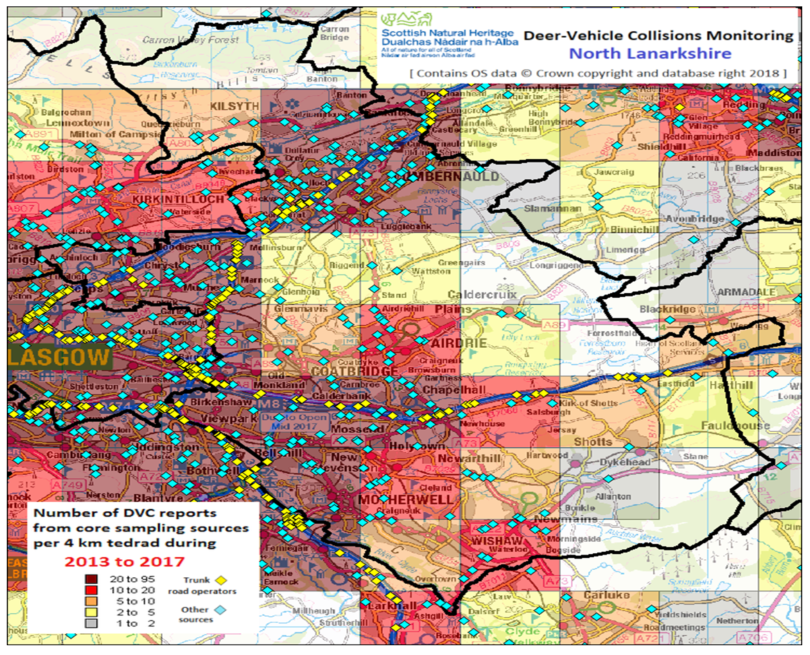
In order to address this issue, a full excel sheet was kindly provided by NLC, which allowed some detailed analysis to take place and to identify current NLC hotspots. This data originates from a NLC database, which records details of public calls to request animal carcass pick-ups and which does allow a search for ‘deer’ incidents. The database covered from 2009 until now (cf. 2017 for national SNH database). In order to try and avoid duplication of data during the analysis, any reports of deer within two days of each other at the same location e.g. by 2 or 3 separate members of the public, were considered as ‘one DVC’ on the basis that the NLC ‘Pick-up’ teams aim to collect carcasses within 1-2 days.
Therefore, in order to obtain a minimum estimate of reported DVCs in North Lanarkshire and avoid the risk of duplications, the NLC ‘pick-up’ team data and data that related only to motorways (where NLC does not operate) were combined to provide total DVCs for the whole of North Lanarkshire, different parts of North Lanarkshire, and even different roads.
When examining this data, it is essential to remember that this only relates to those DVCs which have been reported to the relevant authorities and organisations. Langbein (2017) and Langbein & Putnam (2007) estimate that anything between 50-80% of DVCs go officially unreported, either because the deer is not killed instantly and runs off, or the carcass is not left or spotted on the carriageway.
This data can be studied in Appendix 7. However, a summary of the data is presented here, in Table 6 and Figure 2 below.
Table 6 - total recorded DVCs in North Lanarkshire 2009-2017
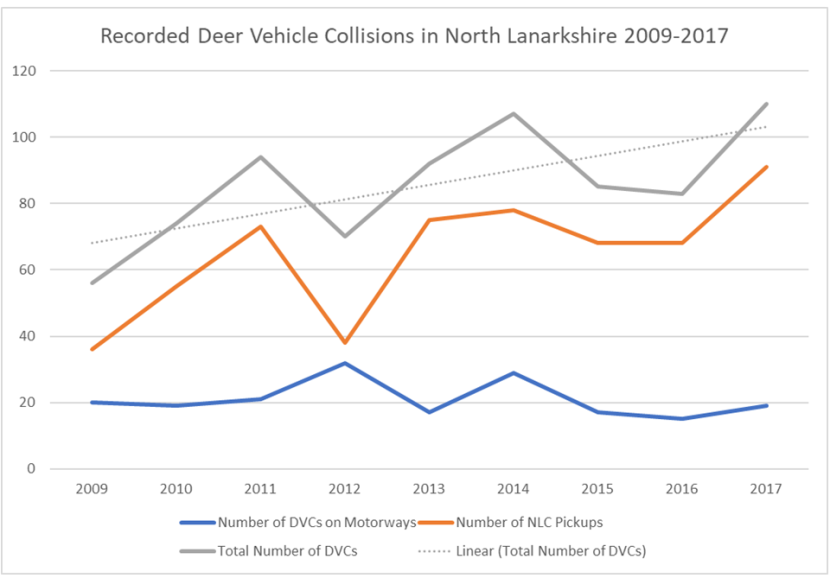
Graph showing recorded deer vehicle collisions in North Lanarkshire 2009-2017
Grey line - Total number of DVCs - fluctuates below 60 to above 100
Orange line - Number of NLC pickups - fluctuates below 40 to above 80
Blue line - Number of DVCs on motorways - fluctuates above 20 to below 20
Grey dotted line - Linear (total number of DVCs) - rises from above 60 to above 100
Graph showing number of DVCs on motorways, numbers of NLC pickups, total numbers of DVCs, Linear DVCs
Figure 2 - Total number of recorded DVCs in North Lanarkshire 2009-2017
- 2009 = 56
- 2010 = 74
- 2011 =94
- 2012 = 70
- 2013 = 92
- 2014 = 107
- 2015 = 85
- 2016 =83
- 2017 = 110
In terms of area differences, the council area was crudely split up into several areas in order to identify if there were any differences between localities (Appendix 7). This analysis demonstrated that the Cumbernauld zone was by far the worst area for DVCs, with Gartcosh and Motherwell areas almost half that number (but still with a large number of DVCs). The Kilsyth, Shotts and Airdrie zones had lower DVC rates. Many DVCs were reported within close proximity to NLC-managed greenspace and woodland sites e.g. Palacerigg, Drumpellier, Strathclyde Country Parks.
The data in Appendix 7 and Table 6 also show that there has been a steady increase in DVCs in North Lanarkshire over recent years, with the two highest years for NLC pick-up teams being in 2017 and 2018. However, DVCs on motorway stretches within North Lanarkshire have largely remained stable albeit high.
The costs associated with DVCs are covered in Section 11.2 below.
11. Economic Issues relating to Roe Deer in North Lanarkshire
11.1 Woodland and crops
Roe deer can cause severe damage to young seedlings and saplings (as well as to basal growth on species such as Hazel) within a woodland when they reach high densities. This damage can be in the form of lead shoots being browsed as well as external damage to young saplings from fraying by the bucks. This damage is most pronounced in young woodland where woodland creation projects are taking place, rather than older, more mature woodland trees, which are too big and too wide to be subject to roe deer attention (cf. red deer).
One method available to measure this impact on NLC land is through looking at the cost of deer fencing to protect woodland creation and regeneration projects. A breakdown of these costs in recent WIAT projects is presented in Appendix 6. However, in total, current deer fencing costs on 12 NLC woodland creation sites is £303,000. Much of this cost has been covered by the woodland grant.
The total amount spent on deer fencing within North Lanarkshire has not been calculated as party of this study but is likely to be considerable for public agencies, as well as private individuals.
Whilst the cost to prevent damage to new trees and woodland creation projects is relatively easy to quantify, the impact of losses within unprotected woodland is a lot more difficult, in terms of loss of timber value (from lost or badly damaged trees from browsing) in the future. For example, since February 2016, NLC have received an income of £7773 from arboricultural operations on NLC land. This is a small amount and it is unlikely roe deer will significantly impact upon such timber quantities in the future on NLC land, however, they will certainly have impacts on more commercial woodland sites close to NLC land.
Roe deer presence will also have many benefits to woodland ecosystems, but putting a monetary value on this within NLC land is extremely difficult to do, mainly because of our incomplete understanding of the role of roe deer in woodlands. However, roe deer are a natural part of our woodlands and their presence can therefore be assumed to be important for the maintenance of a healthy woodland ecosystem. For example, roe deer preferentially browse on bramble, which could otherwise take over large areas in some incidences, whilst their natural deaths will contribute to food for other species.
The other aspect of damage often associated with roe deer is to agricultural crops and garden plant collections. The extent of this damage is not known within North Lanarkshire. However, roe deer are not normally major agricultural pests, their browsing often stimulating grass and other growth later on in the year (Putnam & Moore, 1998), and discussions with farmers at the edge of Drumpellier and Gartcosh indicates that there is no issue with this aspect.
A brief study of the types of crop grown across North Lanarkshire does not show any immediate correlations between roe deer hotspots and type of crop grown (Appendix 2), although this is worthy of further study as part of any future deer management strategy in the area as agricultural land does play a key role in roe deer movements and densities.
There is no doubt that roe deer do cause severe local damage to private gardens. This current level of damage is impossible to quantify in this project but the damage is currently considered acceptable by the NLC Parks Dept looking after NLC’s 6 main town parks, but no figures are currently available for losses to flowers.
11.2 DVC costs
At the moment it is not possible to put a reliable figure on the financial cost of DVCs within North Lanarkshire and beside NLC land. This is for several main reasons:
- Not all DVCs are reported, with Langbein (2017) estimating that anything from 50-80% of DVCs going unreported.
- If the damage is negligible or minor (less than insurance excess), the car owner is not likely to claim it on their insurance or involve Police Scotland;
- Police Scotland only record collisions where there is injury and their current system does not allow a simplistic search to include incidents involving deer (this would require to be a manual search and there is no staff time currently available for this). It is estimated that about 1.3% of all DVCs result in Personal Injury Accidents (PIAs) (Langbein & Putnam, 2007). In addition, incidents with no injury may not be recorded on the Police Scotland command and control system.
- There is no easy way to find out about insurance claims involving deer beyond contacting each separate insurance company.
Some direct and indirect costs have been published, which at least give an indication of possible costs within North Lanarkshire (Figure 3).
|
Source |
Costs |
|---|---|
|
AA Road Insurance (2009) |
£1400 – Average claim for a DVC (6% of all claims involve missing the deer and hitting a tree or other vehicle) |
|
Langbein & Putnam (2007) |
£1320 – average costs of claim. |
|
Source |
Indirect Costs |
|
JPM Consultants (2011) |
|
|
If minor road closed for 4hrs |
£15,000 per incident |
|
If major road closed for 4 hrs |
£75,000 per incident |
|
If motorway closed for 4 hrs (the model used in the study was the M8 near 7 Lochs Wetland Park) |
£80,000 per incident |
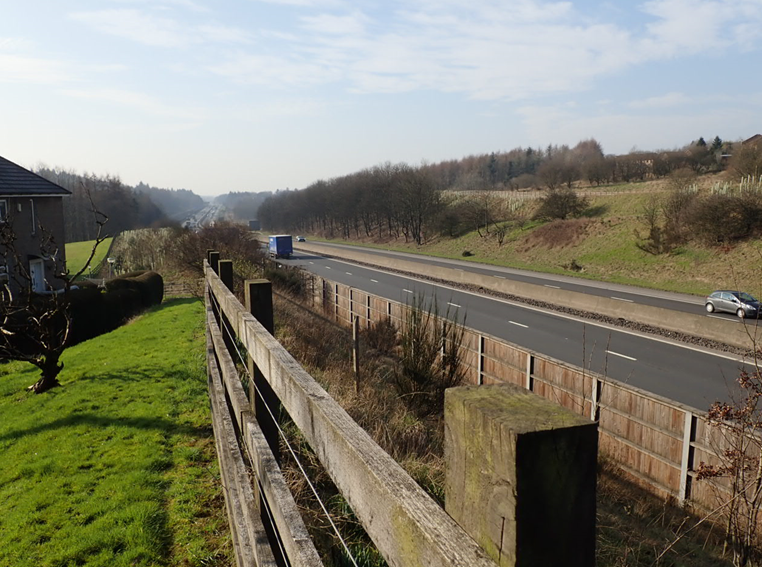
M80 corridor through Cumbernauld. Note heavily wooded areas and one side of motorway with barrier (probably to address noise from traffic).
One final cost relates to the time required to pick up dead deer from roads by NLC teams (and those working on motorways). This has not been quantified but it has been confirmed by NLC that there is no disposal cost as carcasses go into existing waste management streams.
In order to assist in the consideration of the costs of DVCs in North Lanarkshire, the following worked example is used:
In 2017, there were 110 recorded DVCs in North Lanarkshire (Table 5, Figure 3). If this figure is accepted as 50% of the actual number, then 220 DVCs occurred in total. If all these DVCs resulted in damage less than the insurance excess, this would have resulted in £44,000 costs (220 x £200). If 10% of these DVCs resulted in an insurance claim, this would have resulted in (22 x £1400) + (198 x £200) = £70,400 costs. If only one of these DVCs also resulted in a temporary A-road closure, the annual cost of DVCs in North Lanarkshire would reach £145,400.
11.3 Cemetery costs
There are currently 17 cemeteries within North Lanarkshire, of which 10 are operational i.e. not closed.
Roe deer are a common site within the cemeteries, not least because many of them sit within or adjacent to key woodland or habitat corridors, and also because they are quiet, safe places for deer.
From discussions with a sample of cemetery staff, roe deer are a major issue in three cemeteries as they often eat flowers left on top of burial sites as well as flowers left by existing graves. One cemetery manager described how flowers left at a burial site at 11.00am would all be eaten by the time the next burial took place at 2.00pm! This has resulted, on two occasions in the recent past, with NLC having to compensate families for this loss; a total of £2350.
As a result, NLC have invested in cages to protect fresh flowers over burial sites as many cemeteries do not have deer-proof boundaries (with gates often open anyway). These robust cages cost £250 each. A total of 60 cages have been bought for use on all cemeteries in the last two years, costing a total of £15,000. Some cemeteries are worst hit than others, such that the cages have been concentrated at the worst locations, with 8 cages now at Eastfield (Cumbernauld Community Park) and 20 cages at Cambusnethan (by Greenhead Moss LNR). Most other cemeteries do not report any significant issues, which is unexpected, as they are often surrounded by favoured roe deer areas (Appendix 5).
The other cost relates to flowers left by family members on existing gravestones. These are routinely eaten where deer are present. This cost has not been quantified as it is not known how many times this happens (presumably all the time in cemeteries with many deer). In addition, rabbits are present on some cemeteries, such that damage to floral displays will also result from their activities. From discussions with ground staff, it would appear that this damage is accepted by many members of the public but also causes understandable upset amongst others.
11.4 Venison
Roe deer are legally shot in North Lanarkshire on non-Council land, and on rare occasion, on Council land in the past (where it has been permitted to address severe browsing damage). Unfortunately, there is also probably a significant number of animals being poached/hunted for personal or illegal consumption i.e. not through licensed persons or venison dealers.
However, if a butcher or other retail/catering interest, wishes to legally sell venison, they are required under the Deer (Scotland) Act 1996 to apply for a venison dealer’s licence for such activity from North Lanarkshire Council, Regulatory Services & Waste Solutions, Municipal Buildings, Kildonan Street, Coatbridge ML5 3LF. (Tel. no. 01236 856361). The local Environmental Health officer is the main NLC representative to deal with such applications. In turn, NLC is required to inform SNH of such licences.
In short, the Council guidance states the following:
“A licensed venison dealer who has purchased or received venison from another licensed venison dealer or from a licensed game dealer within the meaning of section 10(5) of the Deer Act 1991 shall be deemed to have complied with the requirements of section 34 of this Act if he has recorded in his book kept in pursuance of subsection (1) of that section-
(a) that the venison was so purchased and received;
(b) the name and address of the other licensed venison dealer or of the licensed game dealer;
(c) the date when the venison was so purchased or received;
(d) the number of carcasses and sex of the venison; and
(e) the species of the deer, provided that it is possible to identify it.”
Thus, there is an opportunity to gain useful information about the extent of venison legally entering the market. However, the NLC Environmental Health Department confirmed that they have had no licence applications in the last year whilst the only application that was pending has been withdrawn. Licences need to renewed annually.
Therefore, there are currently no licensed venison dealers based in North Lanarkshire at the moment. There appears to be only one known deer larder within North Lanarkshire which fully meets all the specifications, however, this requires further research. This larder is managed by the North Lanarkshire Deer Management Group (NLDMG), a member of the Lowland Deer Network Scotland (LDNS), and can hold 15-20 carcasses. The FCS also have a larder outwith North Lanarkshire, at their offices in West Calder, that can hold 60 more carcasses, although, like the NLDMG’s larder, not all carcasses will have been sourced from sites in North Lanarkshire.
Therefore, there is a current lack of data on how much venison is being sourced from North Lanarkshire although there is unquestionably venison being used for personal consumption or illegal supply.
11.5 Health and Well-being benefits
Roe deer are a popular sight amongst the public, with most people now seeing them regularly, whether on the side of the road or during walks. However, it is impossible to put a monetary value on the benefits of roe deer to the public as they are one part of nature. It is fully recognised by health organisations that exposure to nature and wildlife plays a vital role in contributing to the mental and physical health of the public. This will naturally apply to people living in North Lanarkshire, as demonstrated by numerous positive references to wildlife within NLC woodland management planning consultations.
12. Neighbouring Land Managers and Public Opinion of Deer in North Lanarkshire
As part of this study, a number of other organisations which manage land adjacent or close to NLC land were contacted for their views on roe deer management within the North Lanarkshire area. The following observations are relevant to future consideration of deer management within NLC land:
1. Roe deer numbers were often not the No. 1 priority for NGO partners during their site management, for a multitude of different reasons, some of which are outlined below. Anti-social activities and vandalism were seen as the biggest problems in many places.
In the case of RSPB, the woodland feature is not the main interest at Baron’s Haugh Reserve so less attention has been placed upon it, although the site manager there noted up to 7 roe deer on occasions and felt there were many more un-counted within the reserve.
For the SWT in Cumbernauld (Appendix 8), vandalism e.g. grass fires, encroaching development and removal of exotics are causing more issues at this time. From site visits, there was much evidence of browsing damage, including at Seafar Wood and Forest Nature reserve, and also good regeneration in patches. However, the SWT policy of leaving cut brash on the ground post-thinning may be protecting tree saplings from browsing as the brash inhibits access to the young trees.
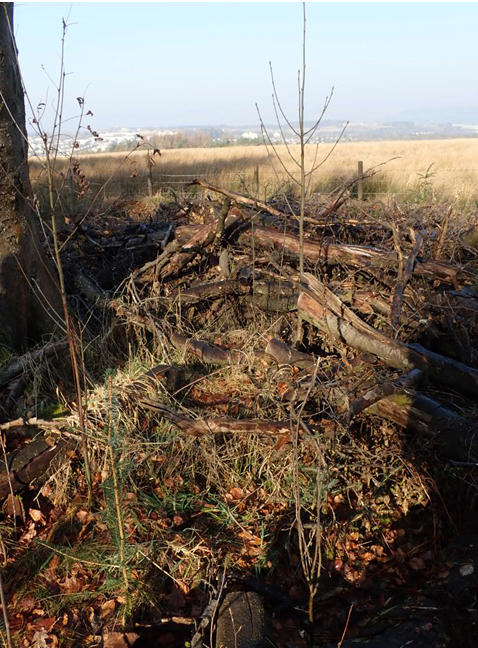
For CSGN, most of the woodlands are 30 years old now, with many trees too big to be affected by roe deer, whilst any new planting tends to be 2 yr whips with individual deer protection.
2. Many statutory bodies currently feel there is a major issue with deer management in and adjacent to NLC land. South Lanarkshire Council at Hamilton Low Parks, Transport Scotland and ScotlandTranServ (M8, M73, M80), SNH, and FCS have all expressed concerns about high roe deer numbers and a lack of deer control with regard to DVCs and woodland damage.
Stalkers from both the North Lanarkshire & South Lanarkshire Deer Management Groups would like to see deer control on NLC land as the current lack of deer management is resulting in sites acting as a source (or reservoir) for roe deer to constantly spread into neighbouring areas. Both groups would be happy to assist NLC with deer management in the future if that was an agreed policy.
3. Most organisations and bodies have a national deer management policy in place or are open to deer control on their land. The exceptions being South Lanarkshire Council and Glasgow City Council, which are currently considering the way forward for future deer management.
All organisations with a national deer management policy would still require a very good case prior to permitting deer shooting on their land. They would only likely take part in such deer management if 1). there was clear evidence of deer impacts, and 2). it was part of larger landscape-scale deer management with clear objectives.
4. With the exception of FCS and occasional sites e.g. Hamilton Low Parks, there is no woodland herbivore impact assessments being carried out in partners’ woodlands adjacent to NLC land. In addition, there are no systematic deer counts beyond data picked up from occasional surveys carried out by SNH.
Many NGOs are not carrying out WHIAs or deer counts, and as such, they do not have the information on which to properly guide their decision-making with regard to deer management at this time.
5. Consultations indicated that there are varied views amongst NLC staff on whether there is a significant deer problem on NLC land. Many staff were cautious about the views of the public towards future deer management.
13. Gaps in knowledge - What data is still required to better inform deer management in North Lanarkshire?
The main finding of this project is that there is a current lack of good quality information on roe deer and their impacts within NLC land and within North Lanarkshire. Table 7 outlines the main areas where data is deficient in order to assist decision-making on how to address these data deficiencies.
|
Issue |
Data Deficiencies |
|---|---|
|
1). Council Plans, Policies and Strategies |
No plans, policies or strategies that specifically deal with deer management within North Lanarkshire Council No plans or objectives that deal with roe deer within the North Lanarkshire Local Biodiversity Action Plan No supplementary guidance notes on deer issues to assist developers No Council Woodland Strategy |
|
2). Inventory of Land |
No up-to-date Phase 1 Habitat Surveys for NLC land and the whole of North Lanarkshire, beyond occasional site. |
|
3). Deer |
Lack of systematic data on roe deer presence and distribution within NLC land, and North Lanarkshire. Lack of frequent, systematic, robust deer count data on NLC and surrounding land Lack of comprehensive deer cull data in North Lanarkshire Lack of more accurate data on deer losses to illegal hunting activities |
|
4). Woodland |
General lack of Woodland Herbivore Impact Assessment data on NLC and other woodland sites since 2011-2013. Lack of woodland condition data for NLC woodland sites e.g. SCM approach. Lack of deer management objectives within NLC woodland management plans (beyond current deer fencing proposals on new woodland creation sites) Need for overall figure for deer fencing costs in North Lanarkshire |
|
5). Statutory Designated Sites |
General lack of Woodland Herbivore Impact Assessment data for woodland within SSSIs sites since 2011-2013. |
|
6). Disease Risk |
No co-ordinated system for Lyme’s Disease surveillance within North Lanarkshire, including lack of any data on current incidents. |
|
7). Wildlife Crime |
Lack of comprehensive data on extent of illegal activities involving deer in NLC land and North Lanarkshire |
|
8). DVCs |
Data is currently satisfactory to help inform decision-making, however, there is a need for a better system across North Lanarkshire to ensure DVC data from NLC teams is in a form that can be used by the national SNH database. Lack of data on accidents involving personal injury and traffic delays as a result of deer. Lack of data on car insurance claims from North Lanarkshire involving deer. |
|
9). Venison |
Lack of data on venison quantities originating from North Lanarkshire |
14. Recommendations and Conclusions
This project has collated and analysed available data relating to roe deer on NLC land and North Lanarkshire, and subsequently, identified gaps in current knowledge on key elements and issues.
At present, there is a significant deficit in data and guidance relating to roe deer and their impacts in North Lanarkshire. This current situation is common across all local authorities in lowland Scotland, and indeed, it is likely that there is more data on issues such as DVCs in North Lanarkshire than other areas. Many of the reasons behind this deficit probably relate to the fact that roe deer have been below the radar for many land managers and authorities until relatively recently, when there has been an apparent significant rise in roe deer, woodland damage and DVCs. As a result, the systems and monitoring have not been in place to systematically collect more information on roe deer before now. Unfortunately, the current lack of data means that it is not possible to carry out a full impact assessment on deer issues on NLC land or North Lanarkshire.
As a result, the 14 Areas of Public Interest (Table 8 below) identified by SNH are not being fully addressed in North Lanarkshire at this time.
|
Key Public Interest |
Current Status |
|---|---|
|
1). Contribute to the delivery of designated features into Favourable Condition through managing deer impacts. |
At present, there is no deer control on NLC land, which is contributing to a constant influx of high deer numbers into surrounding areas, including Hamilton Low Parks SSSI, Garrion Gill SSSI, Bishop Loch SSSI. |
|
2). Contribute to the Scottish Government woodland expansion target of 25% woodland cover. |
At present, NLC is contributing to this target through their current and proposed woodland expansion work. However, there is currently no Woodland Strategy nor Deer Management Plan within NLC. |
|
3). Manage deer to retain existing native woodland cover and improve woodland condition in the medium to long term. |
At present, there is no deer control within NLC land and no information on woodland condition or levels of deer browsing. It is therefore not possible to address this interest. |
|
4). Monitor and manage deer impacts in the wider countryside (not improved agricultural land) |
There is currently no systematic monitoring or management of deer on NLC land. |
|
5). Improve Scotland’s ability to store carbon |
NLC manage a number of bogs and it is felt that roe deer are not an issue with regard to this interest within North Lanarkshire. |
|
6). Reduce or mitigate the risk of establishment of invasive non-native species |
There are currently no non-native deer species within NLC. This element is addressed through their Local Biodiversity Action Plan and other policies. However, a more formal surveillance system may be required. |
|
7). Protect landscapes and historic features from deer and deer management activity |
At present, there is no deer control within NLC land and no information on woodland condition within historic landscapes under their ownership or levels of deer browsing. It is therefore not possible to address this interest. |
|
8). Optimise economic benefits of Deer Management in Scotland |
There is currently no Deer Management Plan in North Lanarkshire and no policy to achieve this interest e.g. no venison strategy. |
|
9). Minimise the economic cost of deer |
There is no control of deer on NLC land such that there is no reduction in the economic impact of DVCs beside NLC land. Deer fencing has been erected on a number of NLC woodland sites such that impacts upon new woodland are being minimised. |
|
10). Contribute to delivering higher standards of competence in deer management |
There is no Deer Management Plan within North Lanarkshire at this time. However, other agencies have a bigger role to play in this interest. |
|
11). Identify and promote opportunities contributing to public health and wellbeing benefits |
NLC manage the largest number of LNRs in Scotland as well as manage 3 major country parks. However, there is no co-ordinated Lyme’s disease surveillance programme in place at the moment nor a plan to reduce DVCs related to NLC land. |
|
12). Ensure effective communication on deer management issues |
There is no communication on deer management issues within North Lanarkshire beyond occasional road warnings on motorways. There is no North Lanarkshire Deer Forum. |
|
13). Ensure deer welfare is taken fully into account at individual animal and population level |
Deer welfare is not being taken into account at this time as there are no plans to assist in the reduction of illegal hunting incidents or DVCs. |
|
14). Develop effective mechanisms to manage deer. |
This study is the first stage in developing effective mechanisms. |
As roe deer do not recognise administrative boundaries, it is essential that actions to address the lack of data and deer impacts within NLC-owned land are not in isolation from surrounding land in North Lanarkshire.
This project has provided the necessary baseline information to allow North Lanarkshire Council and its partners to move on to the next stage in deer management planning. As part of that process, it is recommended that the following actions be prioritised in order to address the most urgent data deficiencies in the short term (within the next 2 years) and to provide the foundations to address other data issues in the medium term (within next 5-10 years):
- Develop a co-ordinated programme of woodland herbivore impact assessments across key woodland sites (and agree acceptable levels of browsing damage);
- Agree a deer survey and monitoring programme with SNH and other partners which provides frequent, robust scientific data around key sites, in particular those around DVC hotspots, SSSIs and key NLC sites;
- Develop a public system of deer sighting reporting across North Lanarkshire;
- Establish a North Lanarkshire Deer Forum with all interested parties, including representatives from the North Lanarkshire Deer Management Group, Police Scotland and SSPCA, in order to start the development of an action plan to address many of the data issues highlighted in this report;
- Commence the development of a Deer Management Strategy and Plan for NLC land and North Lanarkshire, which sets out how the Council will support the 14 Areas of Public Interest.
The final conclusion from this project is that North Lanarkshire Council, SNH and FCS will need to work together with many partners to achieve the sustainable management of deer in the area and thus address the issues highlighted in this report. The good news is that there is much willingness amongst all consultees to engage in such a process. This will hopefully ensure that the messages surrounding roe deer management in the future remain balanced and based on sound evidence.
15. References
AA Insurance: accessed March 2019.
JMP Consultants Ltd 2011. The Indirect Costs of Deer Vehicle Collisions: Final Report for Scottish Naturla Heritage
Langbein, J. 2017. Deer-vehicle collisions in Scotland: data collection and collation to end of 2015. Scottish Natural Heritage Commissioned Report No. 950.
Langbein, J. & Putman, R.J. 2006. National Deer-Vehicle Collisions Project Scotland (2003-2005) Final Report: September 2006. The Deer Initiative Limited.
Mackinlay, L. 2018. Hamilton Low Parks Woodland Herbivore Impact Assessment & Roe Deer Management Recommendations. Unpublished report for Scottish Natural Heritage.
Millins C, Gilbert L, MedlockJ, Hansford K, Thompson DBA, Biek R. 2017 Effects of conservation management of landscapes and vertebrate communities on Lyme borreliosis risk in the United Kingdom. Phil. Trans. R. Soc. B372: 20160123.http://dx.doi.org/10.1098/rstb.2016.0123
McMorran, R., Gibson-Poole, S. & Hamilton, A. 2019. Lowland deer management: assessing the delivery of public interests. Scottish Natural Heritage Research Report No. 1069.
North Lanarkshire Council 2015: North Lanarkshire Local Biodiversity Action Plan 2015-2020.
Patterson G, Nelson D, Robertson P & Tullis J. 2014. Scotland’s Native Woodlands: Results from the Native Woodland Survey of Scotland. Forestry Commission Scotland
Prior, R. 1995 The Roe Deer: Conservation of a Native Species, Quiller, Shrewsbury
Putman, R.J. & Moore, N.P. 1998: Impact of deer in lowland Britain on agriculture, forestry and conservation habitats, Mammal Review 1998.
Scottish Natural Heritage 2008 & 2014: ‘Scotland’s Wild Deer: A National Approach’ (WDNA)
Scottish Natural Heritage 2011: ‘The Code of Practice on Deer Management’
Scottish Natural Heritage 2016: Deer Management in Scotland: Report to the Scottish Government from Scottish Natural Heritage 2016; October 2016.
Watson, A. 2018. Scottish Lowlands Forest District Deer Management Strategy 2018 (Draft). Forestry Commission Scotland
Yalden, D. 1999 The History of British Mammals, T. & A.D. Poyser, London
16. Acknowledgements
I would like to say a big thanks to the many people who gave me their time, knowledge and insights during this work. The list of people to thank is a large one and represents every name on the list of consultees! Everyone was extremely helpful and positive about the project; a good sign for future co-operation on deer management in the area!
17. Appendices
Appendix 1 - 14 Areas of Public Interest (Ref: 'Deer Management Plans - Delivering the Public Interest' (NatureScot))
In line with the Deer Code, the 14 Areas of Public Interest have been grouped into four main headings: Environment, Economy, Social Well-being and Deer Welfare.
Environment
1. Contribute to the delivery of designated features into Favourable Condition through managing deer impacts.
There are around 356 designated features (15.8% of total) within the current Deer Management Group (DMG) network where herbivores impacts are contributing to the unfavourable condition of the feature. It is expected that the DMG will contribute to the Scottish Government target of achieving 80% of features in Favourable or Unfavourable recovering condition by 2016 by facilitating the reduction of herbivore impacts where this is contributing to the unfavourable condition. The DMG will manage deer impacts to deliver and sustain favourable condition of designated features. DMGs may also be able to directly influence non-deer issues for designated sites due to the land management role of their members.
Main public drivers –WDNA, Natura legislation (Birds & Habitats Directives), Nature Conservation (Scotland) Act 2004, Natural Heritage (Scotland) Act 1991. (National Indicator)
2. Contribute to the Scottish Government woodland expansion target of 25% woodland cover.
To achieve this a further 10,000 ha of woodland per year will have to be created. The DMG network area covers some 3,249,442 Ha with significant opportunity to contribute to the delivery of this target through identifying areas for further woodland creation and managing deer impacts to allow for successful establishment of new woodland. Priority should be given to expansion opportunities where this improves habitat networks. It is expected that DMGs will be pro-active in contributing to this target.
Main public drivers – WDNA, Scottish Forestry Strategy, Low Carbon Scotland: Meeting our Emissions Reduction Targets 2013-2027 - The Second Report on Proposals and Policies (RPP2), Scottish Biodiversity Strategy, Woodland Carbon Code. (National Indicator)
3. Manage deer to retain existing native woodland cover and improve woodland condition in the medium to long term.
The Native Woodland Survey of Scotland (NWSS)was published in 2014. This maps non-designated native woodland cover, reports condition and highlights herbivore impacts which threaten medium to long term condition of these important woodlands. It is expected that the DMGs will implement management to reduce the proportion of native woodland area identified within the ‘High’ and ‘Very High’ categories of herbivore impact according to targets set by Scottish Government Agencies. Where other herbivores may be present and contributing to the measured herbivore impact, SNH and FCS will clarify the component of unfavourable condition that needs to be addressed by the deer managers. In areas where DMGs are not functioning, an alternative approach may need to be developed.
Main public drivers – WDNA, Scottish Forestry Strategy, Scottish Bio-diversity Strategy, Woodland Carbon Code. (National Indicator)
4. Monitor and manage deer impacts in the wider countryside (not improved agricultural land) by establishing monitoring throughout wider countryside habitats assessing herbivore impacts and manage those impacts within acceptable ranges (MacDonald et al 19981) to secure sustained presence of these habitats. It is expected that DMGs will take responsibility for the monitoring of herbivore impacts on across the deer range and seek to manage these to contribute to wider ecosystem health.
Main public drivers – WDNA, Scottish Bio-diversity Strategy, Low Carbon Scotland: Meeting our Emissions Reduction Targets 2013-2027 - The Second Report on Proposals and Policies (RPP2). Land Use Strategy. (National Indicator)
5. Improve Scotland’s ability to store carbon by maintaining or improving ecosystem health. In partnership with Government agencies, DMGs will contribute to research and implement and deliver actions to deliver optimum habitat condition for carbon capture and storage.
Main public drivers – Scotland’s National Peatland Plan, WDNA, Low Carbon Scotland: Meeting our Emissions Reduction Targets 2013-2027 - The Second Report on Proposals and Policies (RPP2), Woodland Carbon Code. (National Indicator)
6. Reduce or mitigate the risk of establishment of invasive non-native species by assisting Scottish Government Agencies in monitoring for presence and preventing establishment. DMGs will report sightings and work with SNH to and take action to prevent Muntjac establishment in Scotland and prevent the translocation of Sika and Fallow.
Main public drivers – WDNA, Wildlife & Countryside Act 1981 as amended, Scottish Biodiversity Strategy. (National Indicator)
7. Protect landscapes and historic features from deer and deer management activity. DMGs should consider deer management actions which contribute or impact on delivery of conserving and enhancing the local cultural and historic landscape.
Main public drivers – WDNA, Wildlife & Countryside Act 1981 as amended, Natura legislation (Birds & Habitats Directives), Nature Conservation (Scotland) Act 2004, Natural Heritage (Scotland) Act 1991.
Economy
8. Optimise economic benefits of Deer Management in Scotland by establishing and quantifying current benefits within DMG areas, determining opportunities for increasing economic benefit, particularly where collaborative opportunities exist, and through seeking and promoting investment opportunities which delivers increased economic benefit. DMGs should seek to broaden economic activity associated with deer management through sport, tourism, and venison production.
Main public drivers – WDNA, Scottish Government Economic Strategy, Scottish Government Economic DevelopmentStrategy, Land Use Strategy. (National Indicator)
9. Minimise the economic cost of deer through identifying issues and implementing management to reduce or mitigate deer impacts where this results in an economic cost. DMGs will be active in understanding where deer are having an economic cost particularly with regard to forestry and agricultural impacts, deer vehicle collisions, and seek to plan and work collaboratively to reduce these costs.
Main public drivers – WDNA, Deer (Scotland) Act 1996 as amended, WDNA, Scottish Government Economic Strategy, Scottish Government Economic Development Strategy. (National Indicator)
Social Wellbeing
10. Contribute to delivering higher standards of competence in deer management through promoting and offering opportunities for members to take up formal training opportunities, continuous professional development and ensure Wild Deer Best Practice guidance is adopted in deer management activities throughout the DMG.
Main public drivers – WDNA, Code of Practice for Deer Management, Wild Deer Best Practice Guidance. (National Indicator)
11. Identify and promote opportunities contributing to public health and wellbeing benefits associated with deer and deer management. DMG should raise awareness of road safety issues associated with deer to reduce the risks of road traffic accidents, co-ordinate action to minimise deer-related human disease risks and promote the following of the Scottish Outdoor Access Code.
Main public drivers – Scottish Government Strategic objective -Healthier (National Indicator) WDNA, Transport Scotland - Strategic Road Safety Plan, Deer (Scotland) Act 1996 (as amended). (National Indicator). Land Reform (Scotland) Act 2003.
12. Ensure effective communication on deer management issues within the DMG,; within the wider community and promote better awareness and education of deer and deer management. Ensure DMGs are inclusive, open and transparent, and can articulate and communicate public benefits being delivered through deer management activity.
Main public drivers – WDNA, Code of Practice for Deer management, RACCE committee recommendations (National Indicator).
Welfare
13. Ensure deer welfare is taken fully into account at individual animal and population level through effective planning and delivery of deer management activities. DMGs should carry out an assessment of welfare state of deer and promote positive welfare.
Main public drivers – WDNA, Code of Practice on Deer Management. Collaboration & Effective Deer Management Planning & Implementation
14. Develop effective mechanisms to manage deer. DMGs should improve representation and membership of DMGs to ensure there is greater integration of different land-uses at a local level. DMGs should also ensure that the deer management planning process is consultative, transparent and open. Main public drivers – WDNA, RACCE Committee recommendations.
Appendix 2 - Agricultural Data for North Lanarkshire
Holdings with crops and grass in North Lanarkshire
| North Lanarkshire UA |
North Lanarkshire Holdings |
Hectares |
|---|---|---|
| Cereals | 20 | 939.8 |
| of which: Total barley | 18 | 422.5 |
| Stockfeeding crops | 7 | 42.8 |
| Fruit and vegetables | 8 | 15.8 |
| All other crops | 7 | 11 |
| Fallow land for 5 years or less | 17 | 208.5 |
| Fallow land for more than 5 years | 15 | 109.8 |
| Total crops, fallow and set-aside | 51 | 1,327.70 |
| Common grazing land | 0 | 0.0 |
| Grass under 5 years old | 94 | 983.1 |
| Grass 5 years and older | 366 | 13,089.1 |
| Rough grazings | 200 | 4,742.6 |
| Total grass and rough grazing | 471 | 18,814.8 |
| Utilised agricultural area | 489 | 20,142.50 |
| Woodland | 173 | 4,812.50 |
| Other land | 230 | 751.6 |
| Total agricultural area | 511 | 25,706.60 |
Statistics prepared by Scottish Government RESAS Statistics(Agriculture)
The majority of the cereals grown are in Cadder and Old Monkland district (749ha), with Cumbernauld, New Monkland and Kilsyth (69.4ha) and Bothwell, Cambusnethan, Dalziel and Shotts (121.4ha).
No Oil-seed rape is currently grown in North Lanarkshire (can be a favourite food of roe deer in late winter)
Appendix 3 - Roe Deer Counts in North Lanarkshire and Central Scotland
|
Location |
Date
|
NLC-owned |
Count Method |
Area (ha) |
Minimum Numbers |
Minimum Density (Deer/km2) |
|---|---|---|---|---|---|---|
|
Drumpellier Country Park and immediate environs1 |
2013 |
Yes |
TI |
3365 |
12 |
3.5 |
|
Drumpellier Country Park and immediate environs1 |
2018 |
Yes |
TI |
336 |
28 |
8.5 |
|
Palacerigg Country Park & immediate environs (inc Forest Nature Reserve) |
2013 |
Yes |
TI |
2915 |
42 |
14.5 |
|
Strathclyde Country Park1 |
2013 |
Yes |
TI |
400 (648ha5 inc SLC side) |
17 |
4 |
|
Hamilton Low Parks (W. of M74 only)2 |
2018 |
SLC |
Binos (dawn) |
200 |
27 |
13 (up to 21 in NW corner) |
|
Heathland Forest Complex3 nr. Forth/Breich |
2017/2018 |
FE |
EDU |
3900 |
780 (tbc) |
20 |
|
Carron Valley3 |
2000/2001 |
FE |
EDU |
3000 |
174 (tbc) |
5.8 |
|
Bothwell Park1 |
2011 |
Yes |
TI |
38.8 |
4 (15)5 |
10 |
|
Greenoakhill (S.Glasgow)3 |
2017 |
FE |
TI |
96.1 |
64 |
676 |
|
Cardowan Moss1 (7 Lochs) |
2011 |
? |
TI |
100 |
10 |
10 |
|
Eurocentral1 |
2013 |
? |
TI |
100 |
12 |
12 |
|
Mossbank1 (north of Newarthill) |
2013 |
? |
TI |
100 |
5 |
5 |
|
Hall Gill area1 |
2018 |
Yes |
TI |
100 |
15 (25)4 |
15 |
|
Callendar Woods3 |
2011 |
No |
TI |
94.95 |
17 |
18 |
|
Hillhouseridge (nr. Shotts)1 |
2011 |
No |
TI |
50 |
10 |
20 |
| Location | Date | NLC-owned | Count method | Area (ha) | Minimum numbers | Minimum Density (Deer/km2) |
|---|---|---|---|---|---|---|
|
North Glasgow1 (Bishopbriggs-Killermont-Milngavie (E)-Torrance |
04/2011 |
No |
TI |
3000 NS5775-NS6275-NS6271-NS5771 |
109 |
3.6 |
|
Glasgow East1 (Robroyston-Lenzie-Auchenloch) |
01/2011 |
No |
TI |
900 NS6371-NS6571-NS6569-NS6369 |
65 |
7 |
|
North Moodiesburn1 (Moodiesburn-Kirkintilloch-Blackwood (Cumbernauld)) |
01/2011 |
tbc |
TI |
900 NS6874-NS7074-NS7072-NS6872 |
47 |
5 |
|
Bishop Loch1 (East Glasgow) |
02/2018 |
No |
TI |
600 NS6966-NS6766-NS6767-NS6967 |
51 |
8.5 |
| Average Density | 6 |
1= Only counts included were those where the route allowed satisfactory coverage of the area (often doing a ‘box’ around a discrete patch), although all counts must be viewed as minimum counts as they were often done from vehicles at night and some terrain was not surveyed.
2= This work formed part of the Woodland Herbivore Impact Assessment and Deer Management Recommendations for Hamilton Low Parks SSSI.
3 = This data has been taken from Watson (2018)
4 = Hall’s Gill (Cambusnethan & Carbarns Wood) = 15 during night survey April 2018 but 25 during daytime recce..considered minimum as usual.
5 = 4 (Jan 2011) but 15 counted by member of public in afternoon more recently (Watson, 2018)
6 = In 2017, Greenoakhill was surveyed using thermal imaging and it was estimated there was a population of ~67 deer per 100 Ha. Using already acquired knowledge and skills, the team was able to implement a successful deer management regimen on this site and will continue to do so. Following the initial count, the population on Greenoakhill is now stable at around 6-9 deer per 100 Ha.
TI = Thermal Image Equipment
EDU = Estimated Deer Utilisation (EDU) method
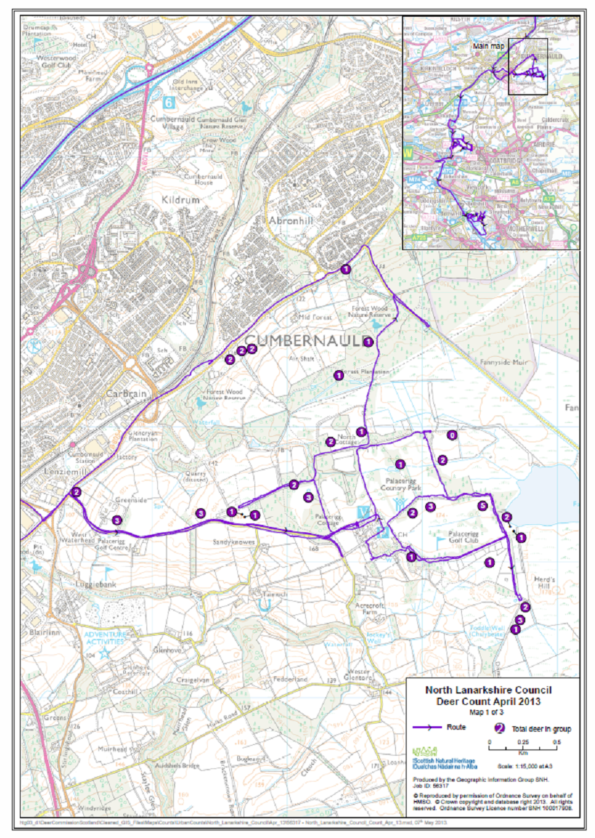
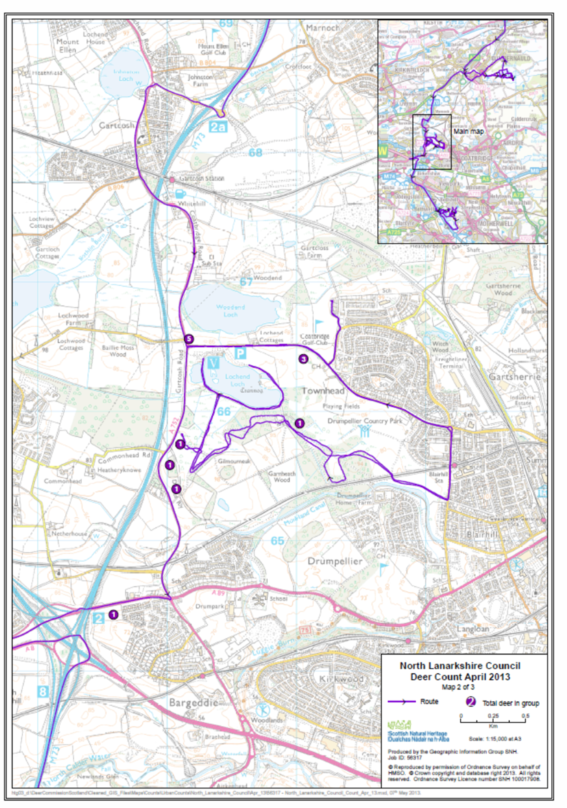
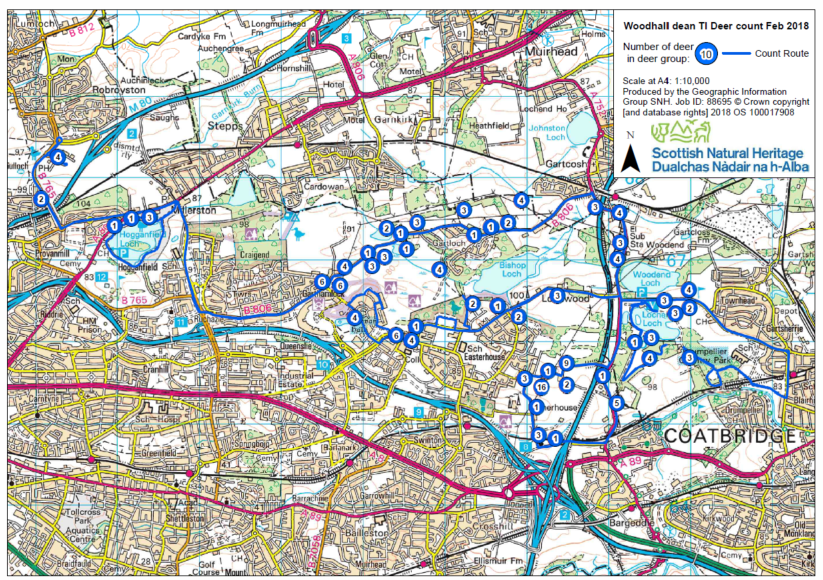
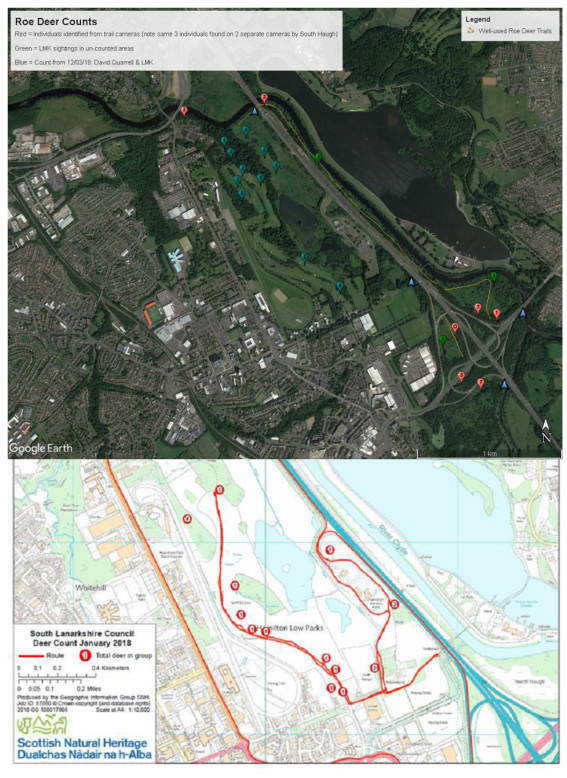
Legend showing well-used roe deer trails
Appendix 4 - Status of Roe Deer on Statutory Designated SSSIs with Woodland within and directly adjacent to North Lanarkshire
|
SSSI |
Grid Ref |
Woodland Condition |
WHIA or Deer Monitoring? |
Level of Roe Deer Damage NWSS (2011-2013) |
Level of Roe Deer Damage Now (2018-) |
|---|---|---|---|---|---|
|
Dullatur Marsh |
NS 755779 |
Favourable maintained (2007): woodland only part of ‘mire range’. |
No – deer not mentioned as an issue. |
Medium |
Unknown |
|
North Bellstane Plantation |
NS 758716 |
Unfavourable (No change): heavy grazing from livestock; non-native tree spp (2009) |
No* |
Medium |
Unknown |
|
Woodend Loch (NLC-owned) |
NS 705667 |
Unknown as woodland not monitored (not a notifiable feature) |
No – no mention of deer in SMS (2010) |
Medium |
Unknown |
|
Garrion Gill |
NS 808527 |
Fav (maintained) 2009 – issues with livestock grazing in places.
|
No mention of deer in 2009; Yes (2016) - LOW woodland impact (but marginal with MEDIUM) |
Medium/High |
Unknown |
|
Hamilton Low Parks |
NS 718 573 |
Unfavourable (re: herons, not woodland) |
No but regular mention of deer browsing in mgt notes pre-2011. |
Medium (Low to High in places) |
High |
|
Millburn |
NS 785513 |
Unfavourable (partially lost to A72) in 2007 |
Yes – 2019 (3 deer counted); No mention in 2007. |
High |
Unknown |
|
Bishop Loch |
NS 688668 |
Unfavourable no change (2010) – INNS main issue in woodland areas, which are part of transition fen feature. |
No No mention of deer in 2010 SMS. |
High (Low to Very High) |
Unknown |
* = North Bellstane Plantation SSSI (2009): - “The woodland is not subject to high browsing pressure from deer although roe deer are present in various parts of the site…..Browsing by deer and other wild herbivores is currently at an acceptable level but future impact should be monitored’.
Note that the NWSS does divide between % of deer and livestock damage where both present e.g. Millburn.
Note the following SSSIs are located within North Lanarkshire but are NOT considered in this analysis as they do not have any notifiable or significant areas of woodland habitats present within them:
- Black Loch Moss SSSI/SAC - bog
- Corrie Burn SSSI – geological
- Hassockrigg & North Shotts Mosses SSSI/SAC (N.Shotts) - bog
- Lady Bell’s Moss SSSI - bog
- Longriggend Moss - bog
- Mollinsburn Road Cutting – geological
- Slamannan Plateau SSSI/SPA - birds
- West Fannyside Moss SSSI/SAC – bog
Appendix 5 - Status of Roe Deer on North Lanarkshire Council-owned Sites
|
Country Park |
Grid Ref |
Area (ha) |
Habitat Suitability for Roe Deer1 |
Roe Deer present/absent2 |
|---|---|---|---|---|
|
Drumpellier |
NS 70421 66413 |
336 |
High |
Yes (‘healthy popn’ in 2007) |
|
Palacerigg |
NS 78567 73296 |
291 |
High |
Yes (‘established popn’ in 2007) |
|
Strathclyde |
NS 73091 56884 |
400 |
High |
Yes (‘small popn’ in 2007) |
|
|
Total Area |
1027 |
|
|
1 = All Country Parks had mixes of woodland and grassland, often coupled with wetland features, providing an excellent mosaic of different habitats and habitat edges for roe deer.
2 = The presence/absence of roe deer was obtained from public visitor information on the NLC website, via conversations with NLC staff, information from management plans (in italics), and the NLC website, as there was little data from other sources.
|
Garden |
Grid Ref |
Area (ha) |
Habitat Suitability for Roe Deer1 |
Roe Deer present/absent2 |
|---|---|---|---|---|
|
Colzium Estate & Museum |
NS 72886 78729 |
? |
High |
Yes (noted in 2007). Reports of deer issues (via Parks Dept) |
|
Dalzell Estate |
NS 76014 55011 |
? |
High |
Yes (noted in 2007) |
|
Viewpark Gardens |
NS 70854 60825 |
? |
Unclear at this time: beside woodland but protected by high walls?? |
Unknown |
|
|
Total Area |
?? |
|
|
1 = Dalzell and Colzium had mixes of woodland and grassland, often coupled with other features, providing an excellent mosaic of different habitats and habitat edges for roe deer.
2 = The presence/absence of roe deer was obtained from public visitor information on the NLC website, via conversations with NLC staff, information from management plans, and the NLC website, as there was little data from other sources.
|
LNR Site |
Grid Ref |
Area (ha) |
Habitat Suitability for Roe Deer1 |
Roe Deer present/absent2 |
|---|---|---|---|---|
|
Braedale Hill |
NS 82854 56114 |
20.14 |
High |
Not formally recorded |
|
Brownsburn Community Park |
NS 76705 64150 |
62 |
High |
Yes |
|
Cambusnethan Woodlands (inc Hall’s Gill) |
NS 78091 53352 |
42.5 |
High |
Yes |
|
Dumbreck Marsh |
NS 70709 77213 |
76.29 |
High |
Yes |
|
Gartcosh |
NS 71152 68252 |
28.9 |
High |
Yes |
|
Greenhead Moss Community Nature Park & Perchy Pond |
NS 80883 54605 |
100 |
High |
Yes |
|
Kingshill |
NS 85511 57487 |
112.5 |
High |
Yes |
|
Mosswater |
NS 72149 74760 |
27 |
High |
Not formally recorded |
|
Ravenswood |
NS 74553 73815 |
17 |
High |
Yes |
|
|
Total Area |
486.33 |
|
|
1 = All LNRs had mixes of woodland and grassland, often coupled with wetland features, providing an excellent mosaic of different habitats and habitat edges for roe deer. In many cases, the woodland was still quite young. Many are on previous industrial land.
2 = The presence/absence of roe deer was obtained from public visitor information on the NLC website, management plans or via conversations with NLC staff, as there was little data from other sources.
|
LNR Site |
Grid Ref |
Area (ha) |
Habitat Suitability for Roe Deer1 |
Roe Deer present/absent2 |
|---|---|---|---|---|
|
Belhaven Park |
NS 79345 55685 |
4.5 |
High |
Yes3 |
|
Burngreen Park |
NS 72103 78029 |
4.5 |
Low |
Unknown |
|
Centenary & West End Parks |
NS 74993 65200 |
1.6 |
Moderate |
Unknown |
|
Cumbernauld House Park |
NS 77221 75790 |
19 |
High |
Yes |
|
Duchess of Hamilton Park |
NS 74946 56439 |
7 |
Low |
Unknown |
|
West End Park |
NS 72261 64793 |
9 |
Moderate |
Unknown |
|
|
Total Area |
45.6 |
|
|
1 = The majority of town parks did not hold significant areas of habitat that was suitable for cover for roe deer. Therefore, suitability was judged on links and accessibility to roe deer from neighbouring land and whether such land was optimal for roe deer or not e.g. woodland, semi-natural areas.
2 = No data could be obtained via NLC website, however, thermal image count confirmed some presence in the Cumbernauld House Park area. Parks Dept (NLC) report roe deer as present in parks but acceptable levels of damage. No specific park details at this time.
3 = Scottish Daily Record News
|
LNR Site |
Grid Ref |
Area (ha) |
Suitability for Roe Deer1 |
Roe Deer present/absent2 |
|---|---|---|---|---|
|
Airbles |
NS 74472 56035 |
9.97 |
High |
Yes – no issues |
|
Bedlay |
NS 69777 69965 |
2.97 |
Moderate |
Unknown – no issues |
|
Benhar |
NS 88115 60736 |
1.52 |
High |
Unknown – no issues |
|
Bothwellhaugh |
NS 72925 58535 |
9.14 |
High |
Unknown - no issues |
|
Bothwellpark |
NS 71941 60348 |
8.63 |
High |
Unknown - no issues |
|
Cambusnethan |
NS 80701 55097 |
13.42 |
High |
Yes – major issues; daily sight; up to 7 seen at one time. |
|
Coltswood |
NS 73278 66049 |
3.62 |
Low |
Unknown – no issues |
|
Cumbernauld Village |
NS 76450 75958 |
0.8 |
High |
Unknown – no issues |
|
Eastfield |
NS 75122 75335 |
1.61 |
High |
Yes – major issues; Up to 14 deer in area & 7 seen in cemetery in winter. |
|
Holytown |
NS 77312 60768 |
2.15 |
High |
Unknown – no issues |
|
Kilsyth |
NS 71583 77180 |
4.50 |
High |
Yes – significant issues |
|
New Monkland |
NS 75253 67925 |
8.67 |
Low |
Unknown – no issues |
|
Old Monkland |
NS 71537 63321 |
10.95 |
Low |
Unknown – no issues |
|
Shottskirk |
NS 84316 62958 |
1.78 |
Moderate |
Unknown – no issues |
|
St. Joseph’s |
NS 76223 66925 |
5.90 |
Low |
Unknown – no issues |
|
St. Patrick’s |
NS 75649 59325 |
4.32 |
High |
Unknown – no issues |
|
Stane |
NS 88772 59479 |
1.99 |
Moderate |
Unknown – no issues |
|
|
Total Area |
`91.94 |
|
|
1 = The majority of cemeteries did not hold significant areas of habitat that was suitable for cover for roe deer. Therefore, suitability was judged on links and accessibility to roe deer from neighbouring land and whether such land was optimal for roe deer or not e.g. woodland, R. Clyde, semi-natural areas.
2 = This data was obtained from conversations with some cemetery staff as well as information set out on the NLC website.
There are 32 Cemeteries and Churchyards in North Lanarkshire. Ten of which are operational cemeteries, seven closed cemeteries and fifteen closed churchyards. Cumulatively, they cover approximately 120 ha. However, it was not possible to assess churchyards within this study, which make up 28ha of land.
Appendix 6 - Information on NLC-owned Woodland Sites, including Status of Roe Deer Damage
|
Code |
SINC Site |
Grid Ref (all NS) |
Area (ha) |
|---|---|---|---|
|
76/03 |
Drumpellier (Lochend) Moss & Birchwood |
703658 |
29.06 |
|
76/43B |
Cairnhill Woods: North |
754642 |
10.37 |
|
76/10A |
Luggie Glen (North) |
712642 |
14.66 |
|
76/12A |
Garnheath Wood |
713655 |
12.66 |
|
76/16B |
Monkland Canal (West): Drumpellier Home Farm-Blair Bridge |
719652 |
4.16 |
|
76/20 |
Glenboig Woodland & Inchneuk Moss (East) |
717692 |
17.2 |
|
76/46 |
South Burn |
758652 |
1.19 |
|
77/59 |
Glencryan Woods |
774739 |
3.34 |
|
77/22 |
Colzium-Lennox Estate |
730784 |
44.17 |
|
77/38B |
Dullatur Woods (East) |
746769 |
2.38 |
|
67/12A |
Moodiesburn Glen/Bothlin Burn (South) |
692704 |
14.44 |
|
77/14 |
Drumglass Marsh & Plantation |
724757 |
13.47 |
|
77/38A |
Dullatur Woods (West) |
742768 |
4.93 |
|
77/40 |
Ravenswood Marsh |
745739 |
25 |
|
75/05 |
Dalzell Park |
760550 |
38.25 |
|
75/10 |
Cambusnethan Woodlands |
782533 |
49.24 |
|
85/22 |
Kingshill Wetlands & Plantations (former Bing) |
853568 |
142.7 |
|
85/03 |
Branchal Plantation |
807563 |
20.66 |
|
75/02A |
South Calder Water: Holmforge Bridge-Forgewood Viaduct |
747589 |
17.91 |
|
75/12A |
South Calder Water: Calder Bridge-Coltness Bridge |
796570 |
49.44 |
|
85/02A |
South Calder Water: Coltness Bridge-A73 |
807574 |
28.04 |
|
76/09 |
Gartcosh Nature Reserve |
707685 |
37.41 |
|
- |
- |
Total Area
|
580.6 |
|
Code |
SINC Site |
Grid Ref (all NS) |
Area (ha) |
|---|---|---|---|
|
76/32 |
North Calder Water: Carnbroe Mains-Greenend |
741630 |
0 |
|
76/62C |
North Calder Water: Moffat Mills-Dunrobin |
790650 |
10.96 |
|
77/39C |
Luggie Water: Condorrat Rd-Gainburn Cres |
733725 |
7.68 |
|
76/58 |
North Calder Water: Calderbank-Monkland Br |
773626 |
32.17 |
|
67/12B |
Moodiesburn Glen/Bothlin Burn (North) |
689709 |
0.93 |
|
75/04A |
South Calder Water: Forgewood Viaduct-Calder Park |
756580 |
22.8 |
|
76/18 |
North Calder Water: Bankhead-Viewpark Glen |
715624 |
31.21 |
|
75/08A |
Legbrannock Burn East: Burnside Road |
780598 |
6.46 |
|
- |
- |
Total Area |
112.21 |
| Wood | Grid Ref | Area (ha) |
Level of Roe Deer Damage recorded1 2005-2007 |
NWSS (2011 - 2013) |
Now (2018-) |
|---|---|---|---|---|---|
|
Cairnhill (Petersburn) Woods |
NS 756 641 |
|
Low |
Medium |
Unknown |
|
Cambusnethan & Carbarns |
NS 779 531 |
|
Low |
Medium (High) |
See Halls’ Gill below |
|
Coltness & Branchalwood |
NS 801 574 |
|
Low |
Medium (High) |
Unknown |
|
Colzium-Lennox Estate |
NS 729 787 |
|
Low |
Medium |
Unknown |
|
Dalzell Estate |
NS 760 550 |
|
Low |
n/a |
Unknown |
|
Drumpellier Country Park |
NS 709 660 |
|
Medium |
Medium |
Unknown |
|
Eastfield & Balloch (Cumbernauld Community Park) |
NS 749 755 |
|
Very High |
Medium |
Unknown |
|
Moodiesburn Glen |
NS 694 704 |
8.10 |
Low |
Medium |
Unknown |
|
Palacerigg Woods |
NS 785 732 |
92.5 |
Very High |
Medium |
Unknown |
|
Ravenscraig Gorge (not NLC) |
NS 787 572 |
|
Low |
Medium (High) |
Unknown |
|
Strathclyde Country Park |
NS 732 575 |
|
Low |
Medium |
Unknown |
|
Viewpark Glen |
NS 715 611 |
|
Low |
Medium |
Unknown |
|
Westfield (Broadwood) |
NS730 735 |
|
High |
Medium (High) |
Unknown |
|
Hall’s Gill |
NS 781 533 |
|
Low |
Medium (High) |
Medium (High) |
|
Riccard Johnston |
NS 758 590 |
25 |
n/a (Plan date: 2012) |
Medium |
Unknown |
|
Shields Glen |
NS 767 554 |
|
? |
Medium |
Unknown |
|
Glencryan Woods |
NS 774739 |
56.9 |
Medium |
Medium |
Unknown |
|
Newarthill |
NS 783 593 |
7.40 |
n/a (Plan date: 2016) |
Medium |
Unknown |
|
Thornwood |
NS 700 612 |
9.10 |
n/a (Plan date: 2015) |
Medium |
Unknown |
|
Calderbank & Chapelhall |
NS 772 627 |
22.05 |
n/a (Plan date: 2015) |
Medium |
Unknown |
1 = Level of roe deer damage assessed from management plan observations and any formal assessments; Not recorded (NR), Low (inc Negligible), Medium, High, Very High.
Medium (High) = mainly medium but occasional compartment in area which is High.
n/a = deer damage not identified as cause of woodland herbivore damage.
Medium (NWSS) = Could meet a wide range of objectives but some tree and shrub species may be under-represented in regeneration.
High (NWSS) = Few prospects for tree regeneration but good for plant and animal species that benefit from an absence of a shrub layer/understorey. (tbc).
|
Site |
Grid Reference |
Area (ha) |
Cost of Deer Fencing |
|---|---|---|---|
|
Benhar |
NS881605 |
3.73 |
£7.5k |
|
Chapelhall |
NS775632 |
4 |
£9k |
|
Cumbernauld Community Park |
NS748757 |
5.41 |
£24k |
|
Forgewood |
4.3 |
n/a |
|
|
Kingshill |
NS851574 |
6.3 |
£16k |
|
Carbarns |
NS778540 |
5.71 |
£13k |
|
Millcroft |
NS756722 |
17.29 |
£35k |
|
Cobbleton Road |
NS756588 |
3.16 |
£46k |
|
Sandyknowes |
NS774731 |
8.86 |
£18k (estimate) |
|
Blairlinn |
NS762722 |
4.17 |
£7.5k |
|
Palacerigg |
NS788736 |
300 |
£108k |
Calderbank & Chapelhall WIAT included £28k of deer fencing.
| Site | WHIA Monitoring or Deer counts? | Deer mentioned in Mgt Plans? |
Level of Roe Deer Damage recorded1 NWSS (2011-2013) |
Level of Roe Deer Damage recorded Now (2018-) |
|---|---|---|---|---|
|
Braedale Hill LNR |
No |
No (2013) |
Medium |
Unknown |
|
Brownsburn Community Park LNR |
No |
No (2013) |
Medium |
Unknown |
|
Cambusnethan Woodlands (inc Hall’s Gill) LNR |
Yes (Hall’s Gill subject to WHIA in 2018; Deer Counts in 2018); SCM methods proposed |
No - (Cambusnethan Woodlands Mgt. Plan 2014-2019) Yes – Hall’s Gill Mgt Plan (2018) |
Medium (High) |
Medium ..tbc |
|
Dumbreck Marsh LNR |
Unknown |
Unknown |
Medium (High) |
Unknown |
|
Gartcosh LNR |
No – SCM methods proposed. |
Yes (factor in future woodland mgt but no deer prescriptions in plan; 2014-2019) |
Medium |
Unknown |
|
Greenhead Moss Community Nature Park & Perchy Pond LNR |
No |
Yes (Mgt Plan 2017-2017: ‘Roe Deer: Check runs for snares on a monthly basis’ |
Medium (High) |
Unknown |
|
Kingshill LNR |
No |
No (2011-2016) |
Medium |
Unknown |
|
Mosswater LNR |
Unknown |
Unknown |
High |
Unknown |
|
Ravenswood LNR |
Unknown |
Unknown |
Medium |
Unknown |
1 = Level of roe deer damage assessed from management plan observations and any formal assessments; Not recorded (NR), Low (inc Negligible), Medium, High, Very High.
Hall’s Gill: Moderate Overall Browsing pressure (= Medium).. ‘An undesirable level of herbivore impacts owing to roe deer were recorded at 11 of 15 monitoring points. Evidence of browsing upon native tree seedlings was widely observed’
Medium (NWSS) = Could meet a wide range of objectives but some tree and shrub species may be under-represented in regeneration.
Appendix 7 - Deer Vehicle Collision Data - North Lanarkshire Council 2009-2018
Number of Deer Carcass Uplifts (DVCs) by North Lanarkshire Council: 2009-2018
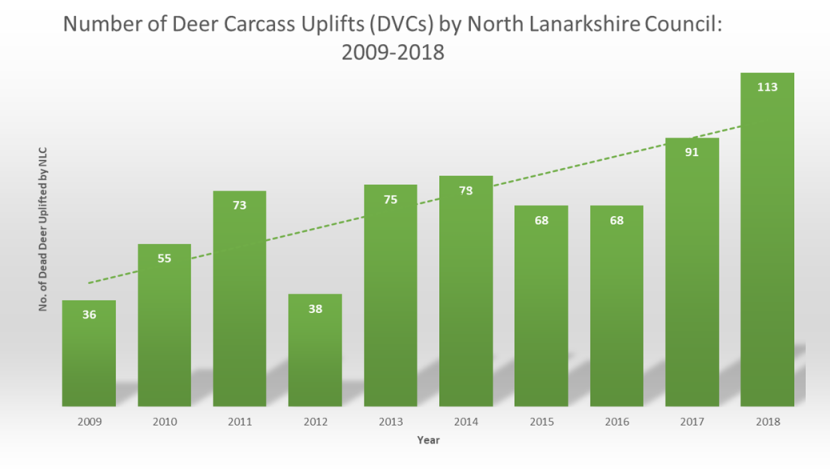
Number of Deer Carcass Uplifts (DVCs) by North Lanarkshire Council: 2009-2018
2009-36
2010-55
2011-73
2012-38
2013-75
2014-79
2015-68
2016-68
2017-91
2018-113
Total No. of Carcasses Uplifted by North Lanarkshire Council 2009-2018
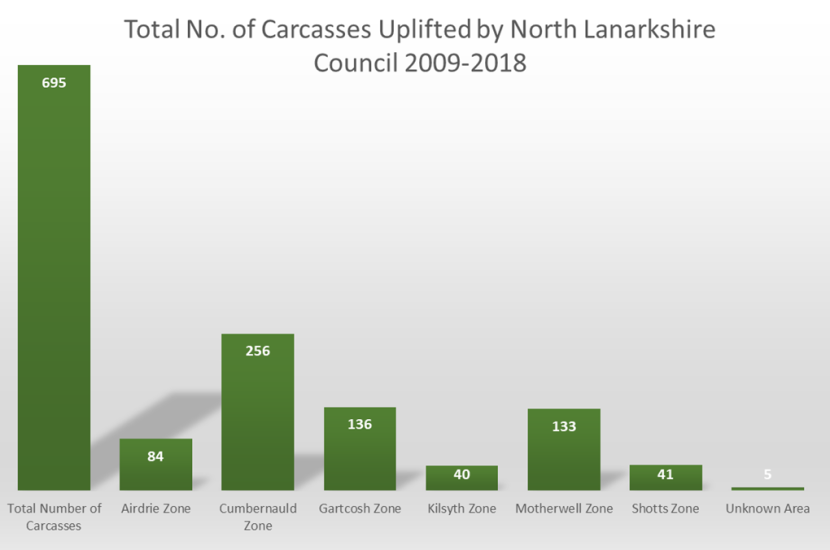
Total number of carcasses uplifted by North Lanarkshire - 695
Airdrie Zone - 84
Cumbernauld Zone - 256
Gartcosh Zone - 136
Kilsyth Zone - 40
Motherwell Zone - 133
Shotts Zone - 41
Unknown area - 5
|
Area
|
Number of Carcasses (2009-2018) |
|---|---|
|
Westfield (Cumbernauld) |
30 |
|
Kilsyth |
27 |
|
Abronhill (Cumbernauld) |
26 |
|
Balloch (Cumbernauld) |
21 |
|
Condorrat (Cumbernauld) |
18 |
|
Gartcosh |
16 |
|
Moodiesburn |
15 |
|
Holytown |
14 |
|
Carrickstone (Cumbernauld) |
13 |
|
Road Name |
Number of Carcasses Picked Up (exc Motorways): 2009-2018 |
|---|---|
|
Forest Road (Cumbernauld) (close to Palacerigg) |
33 |
|
Stirling Road ..review as 2 Stirling Roads (tbc)..(Airdrie/Cumbernauld/Kilsyth) |
25 |
|
Eastfield Road (Cumbernauld) |
23 |
|
Glasgow Road (Cumbernauld/Kilsyth) |
14 |
|
Townhead Rd (by Drumpellier) |
12 |
|
Overtown Road (by Greenhead)) |
11 |
|
Lancaster Ave (Chapelhall) |
8 |
|
Drumcavel Road (Gartcosh) |
7 |
|
Worst roads (inc motorways): Source: SNH (2009-2017) |
|
|
M73 |
85 |
|
M74 |
14 |
|
M8 |
43 |
|
M80 |
47 |
|
A8 |
32 |
|
A725 |
13 |
|
A80 |
5 |
|
A71 |
9 |
|
A73 |
7 |
|
B802 |
6 |
|
Date |
Number of DVCs on Motorways (Source: SNH) |
Number of NLC Pickups (Source: NLC) |
Total Number of DVCs (Motorway & NLC Pick-ups) |
Non-Motorway DVCs (Source: SNH) |
|---|---|---|---|---|
|
2009 |
20 |
36 |
56 |
26 |
|
2010 |
19 |
55 |
74 |
20 |
|
2011 |
21 |
73 |
94 |
27 |
|
2012 |
32 |
38 |
70 |
94 |
|
2013 |
17 |
75 |
92 |
72 |
|
2014 |
29 |
78 |
107 |
48 |
|
2015 |
17 |
68 |
85 |
64 |
|
2016 |
15 |
68 |
83 |
58 |
|
2017 |
19 |
91 |
110 |
86 |
Appendix 8 - Scottish Wildlife Trust Reserve & NLC Woodland Boundaries – Cumbernauld
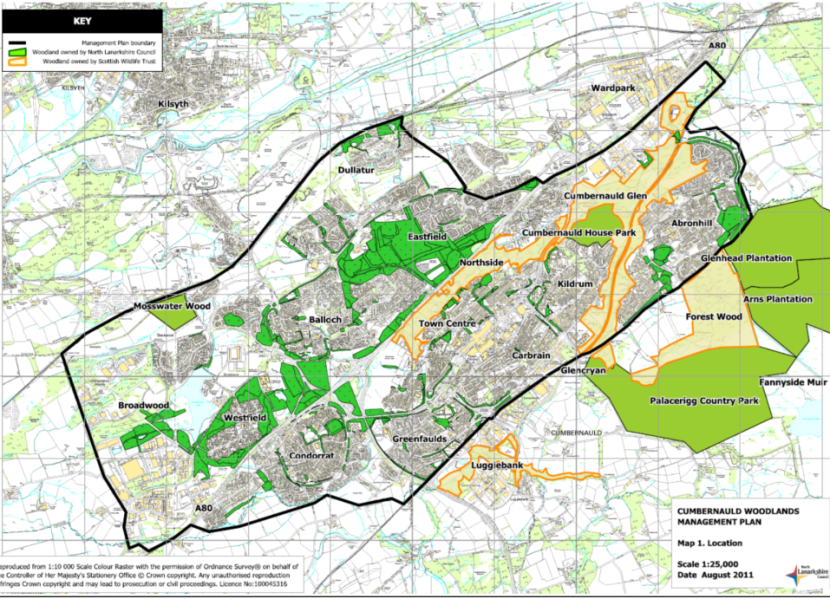
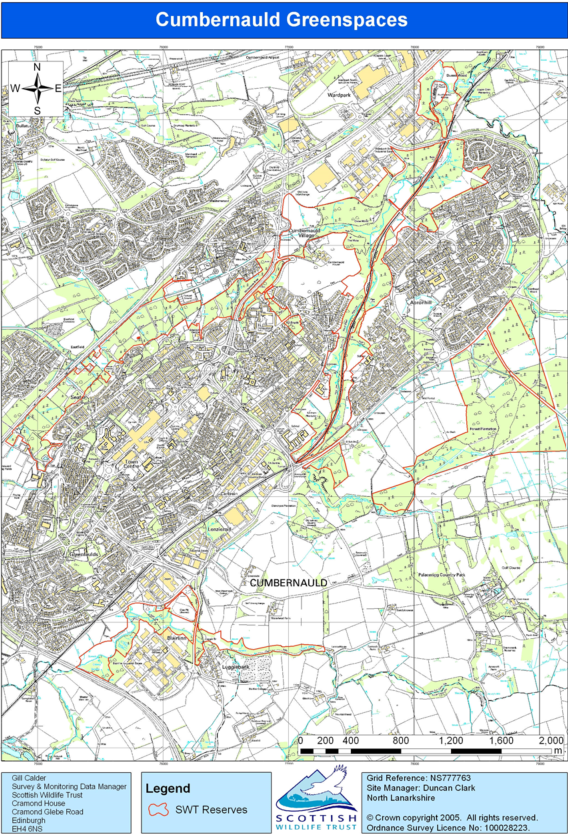
Appendix 9 - List of Consultees who assisted with information and views
|
Name
|
Organisation |
Contact Details |
|---|---|---|
|
Peter Kelly |
SNH |
Operations Officer – Strathclyde & Ayrshire |
|
Jamie Hammond |
SNH |
Wildlife Management Officer | Wildlife Management |
|
Anton Watson |
FCS |
Wildlife Ranger Manager |
|
Yvonne Grieve |
FCS |
|
|
Colin Edwards |
FCS |
Environment Policy Advisor |
|
Pardeep Chand |
NLC |
Forestry and Access Manager |
|
Hayley Andrew |
NLC |
Assistant Business Manager (Greenspace Development) |
|
Vicky Abernethy |
NLC |
Business Manager, Environmental Facilities, North Lanarkshire Council; Tel: 01698 402080 |
|
Kirsty Mooney |
NLC |
Biodiversity Projects Officer |
|
Frank McCool |
NLC |
Cemeteries, Enterprise and Communities, Old Edinburgh Road, Bellshill, ML4 3JF |
|
Sam Kidd |
NLC |
Eastfield Cemetery; tel: 07939 280308 |
|
Ian Clarkson |
NLC |
Cambusnethan cemetery; tel: 07939 284775 |
|
Caroline Thomson |
NLC |
Public Health Department, North Lanarkshire Council, Tel: 01698 858241 |
|
Mhairi Letham |
NLC |
Environmental Health Department, North Lanarkshire Council, Tel: 079511 02026 |
|
Steven Broadfoot |
NLC |
Customer Service & Compliance Manager (Environment & Cemeteries) tel: 01698 506321 |
|
Jim Whittaker |
NLC |
Parks Dept, NLC Tel: 01698 506318 |
|
Aileen McKean |
NLC |
Ranger service, Tel : 01698 402096 [email protected] |
|
Jamie Smith |
NLC |
Drumpellier CP Ranger |
|
Davie McFarlane |
NLC |
Palacerigg CP ranger |
|
Emilie Wadsworth |
CSGN |
Central Scotland Green Network Trust |
|
Scott Ferguson |
7 Lochs Wetland Park |
|
|
Duncan Clark |
SWT |
|
|
Alan Anderson |
SWT |
Head of Reserves |
|
Mark Mitchell |
RSPB (Baron’s Haugh) |
|
|
Angus Corby |
Transport Scotland |
Transport Scotland, Landscape Advisor, T: 0141 272 7256 |
|
Isla Davidson |
ScotlandTranServ |
Ecologist, ScotlandTranServ; T 0141 218 3818 |
|
William Brooks (and members) |
North Lanarkshire Deer Management Group |
tbc |
|
David Quarrell |
South Lanarkshire Deer Management Group |
|
|
PC Douglas Cowan |
Police Scotland (wildlife crime) |
|
|
PC David Hynd |
Police Scotland (roads) |
Police Scotland – Transport Scotland Liaison Officer; [email protected] |
|
Jochen Langbein |
Consultant |
Disclaimer: Scottish Natural Heritage (SNH) has changed its name to NatureScot as of the 24th August 2020.
At the time of publishing, this document may still refer to Scottish Natural Heritage (SNH) and include the original branding. It may also contain broken links to the old domain.
If you have any issues accessing this document please contact us via our feedback form.
